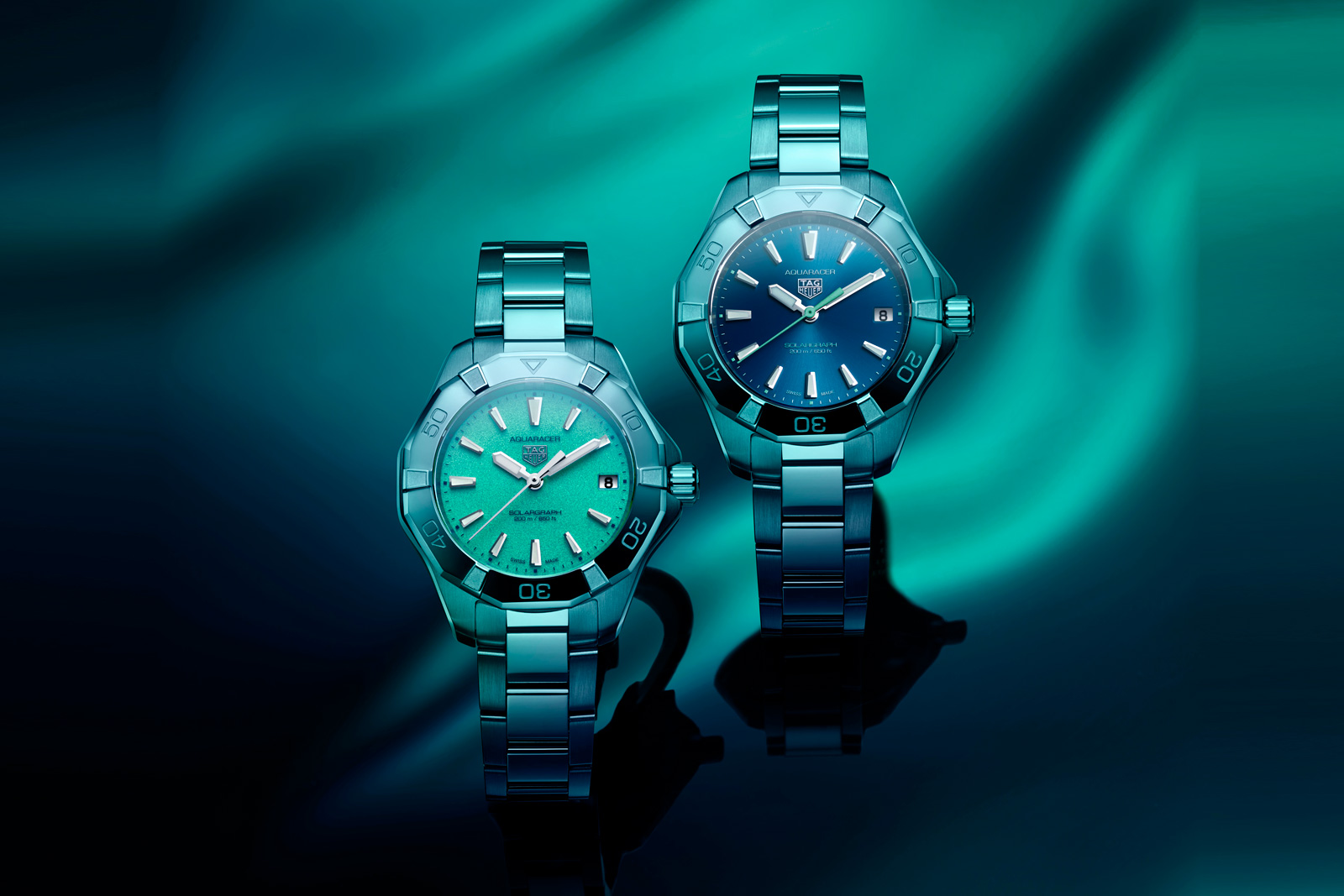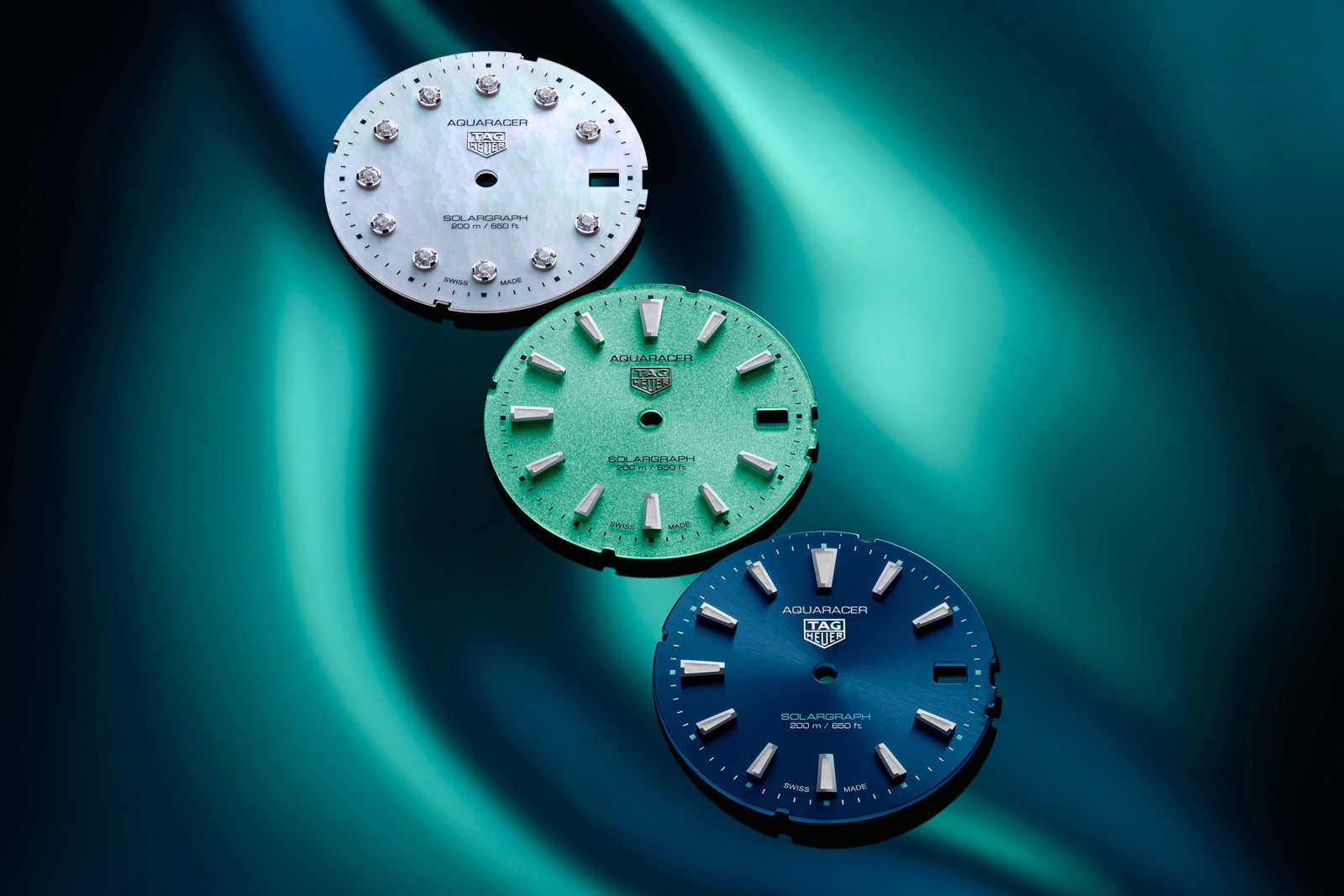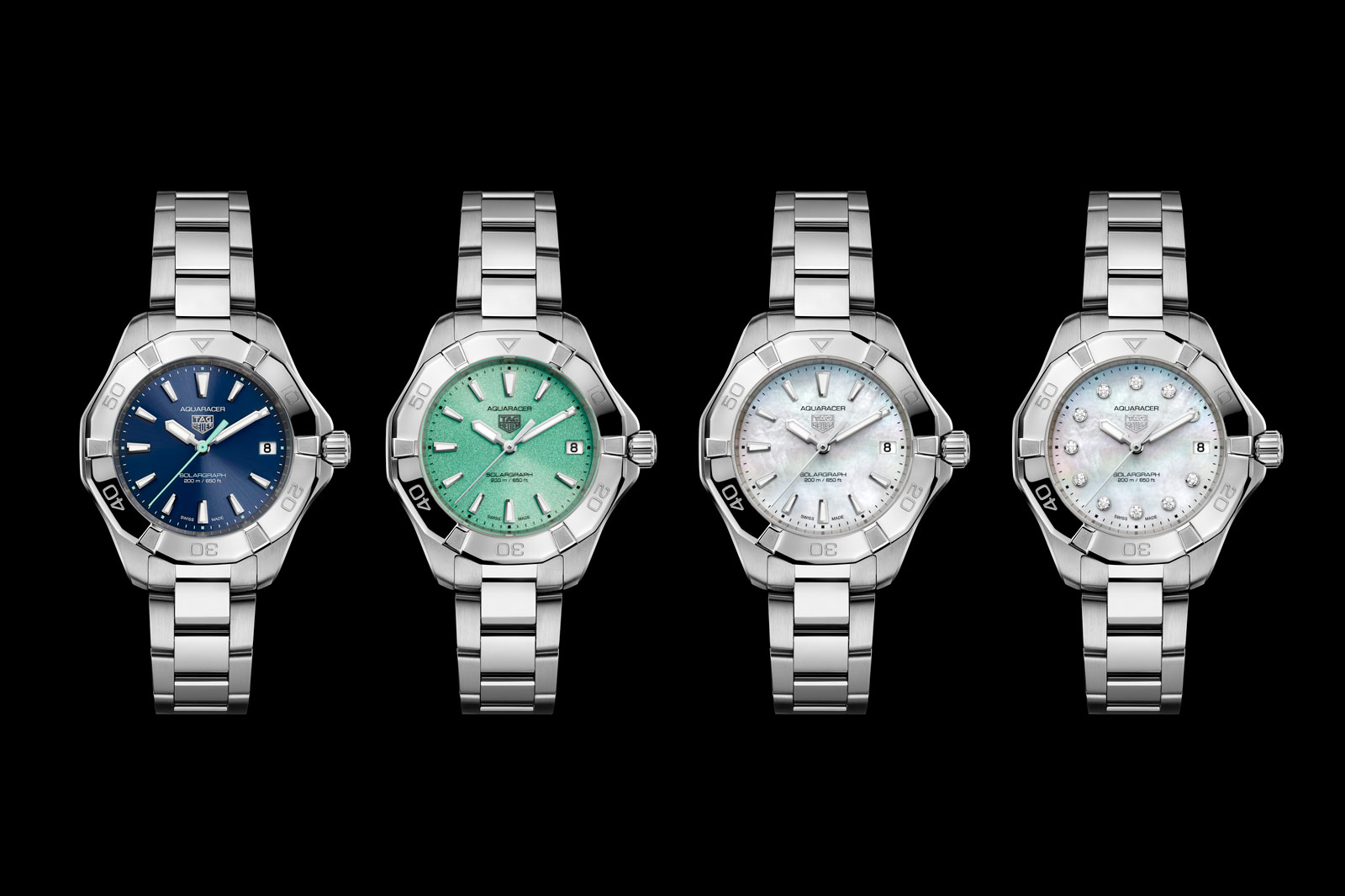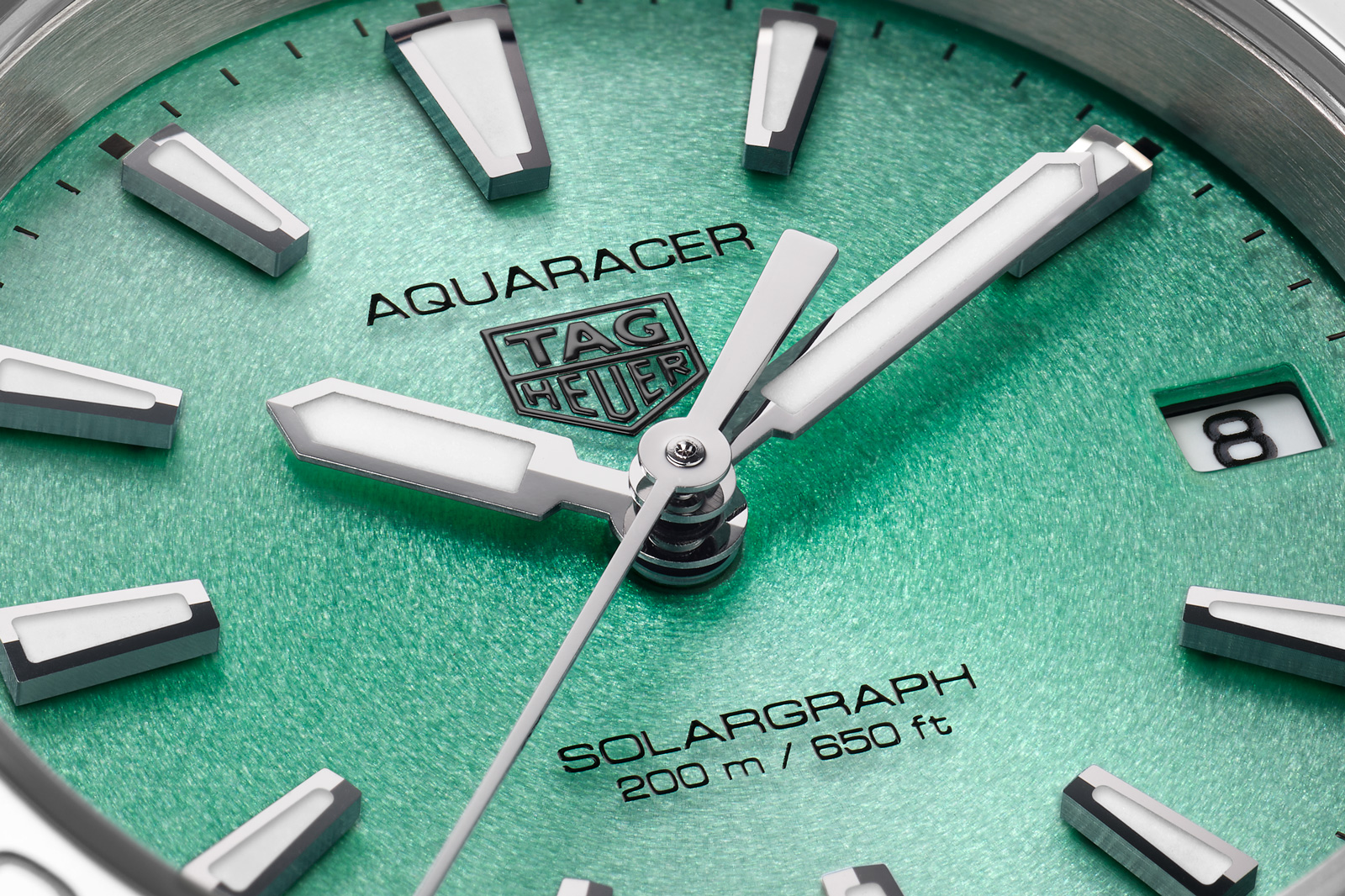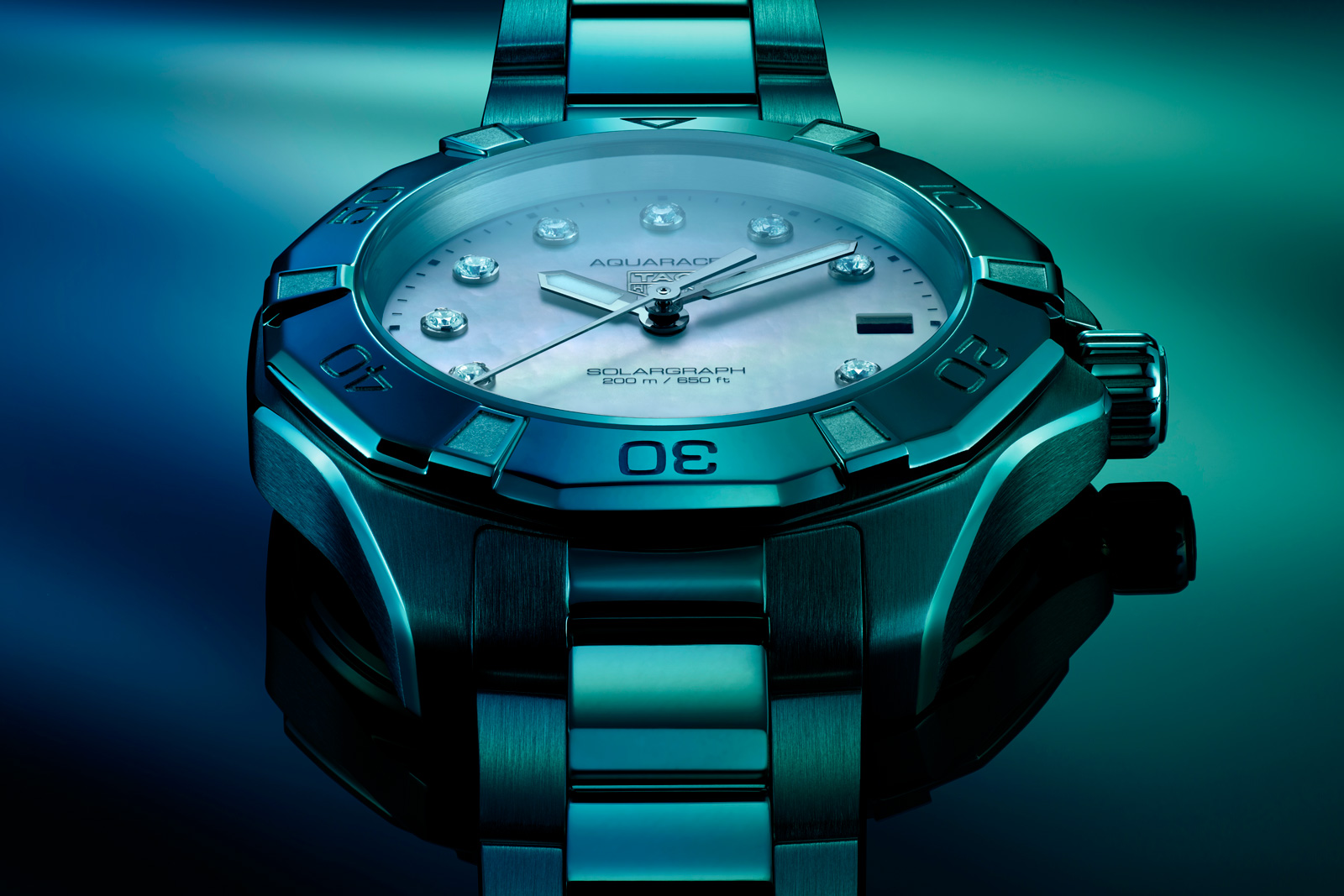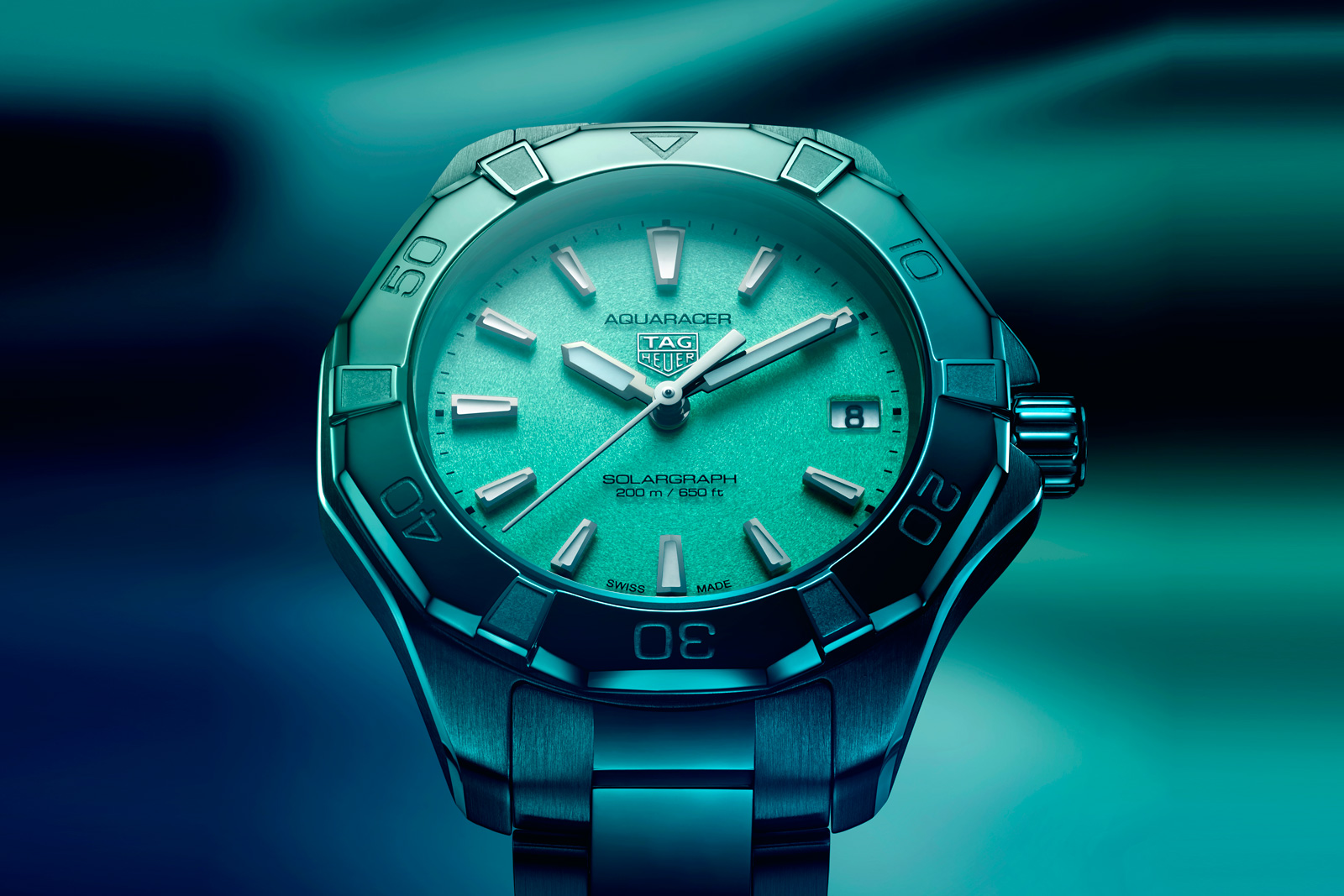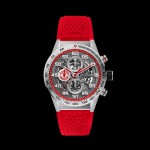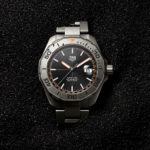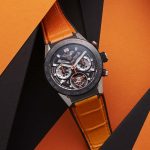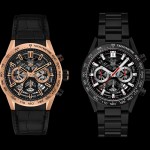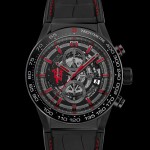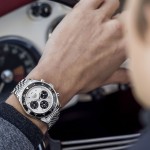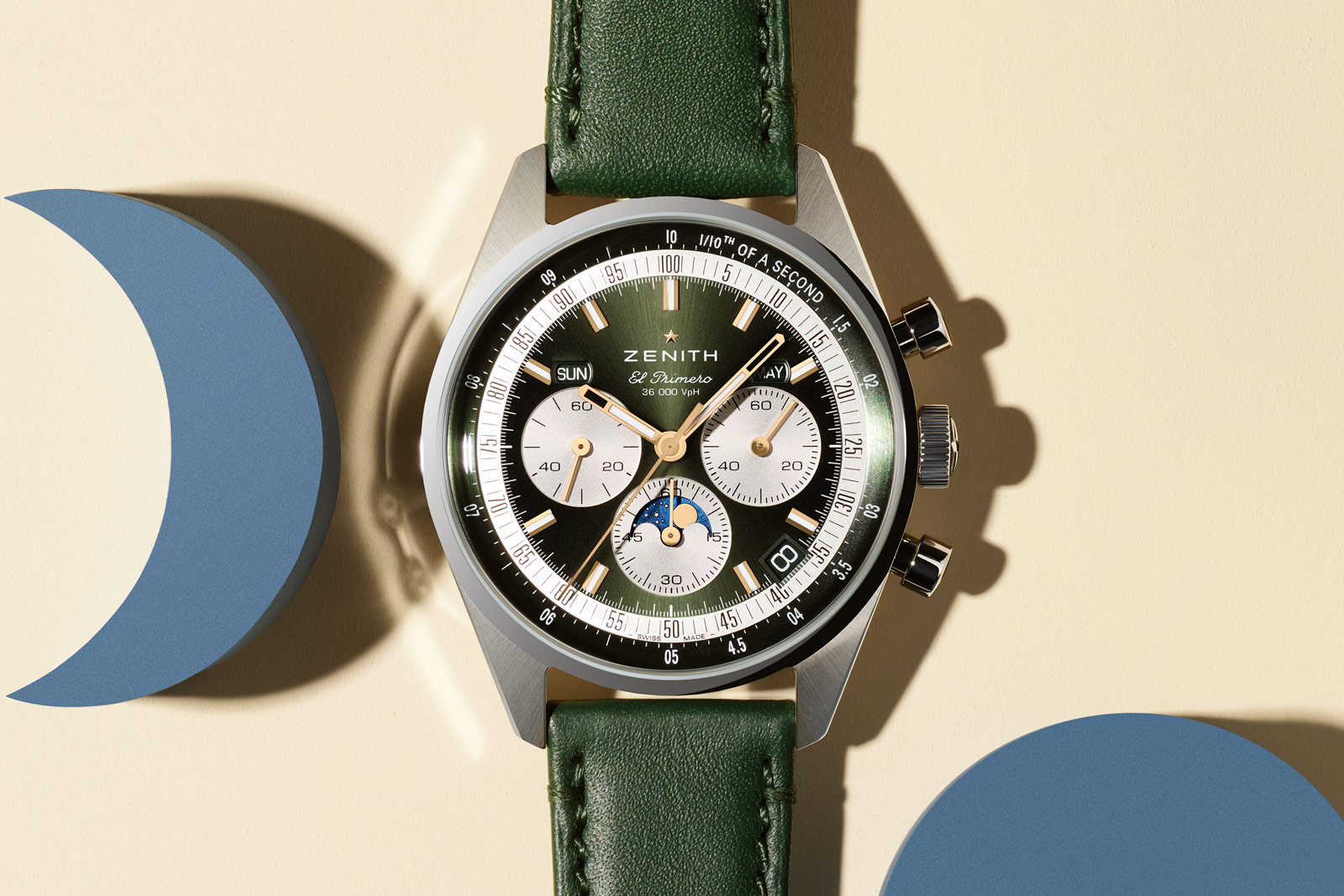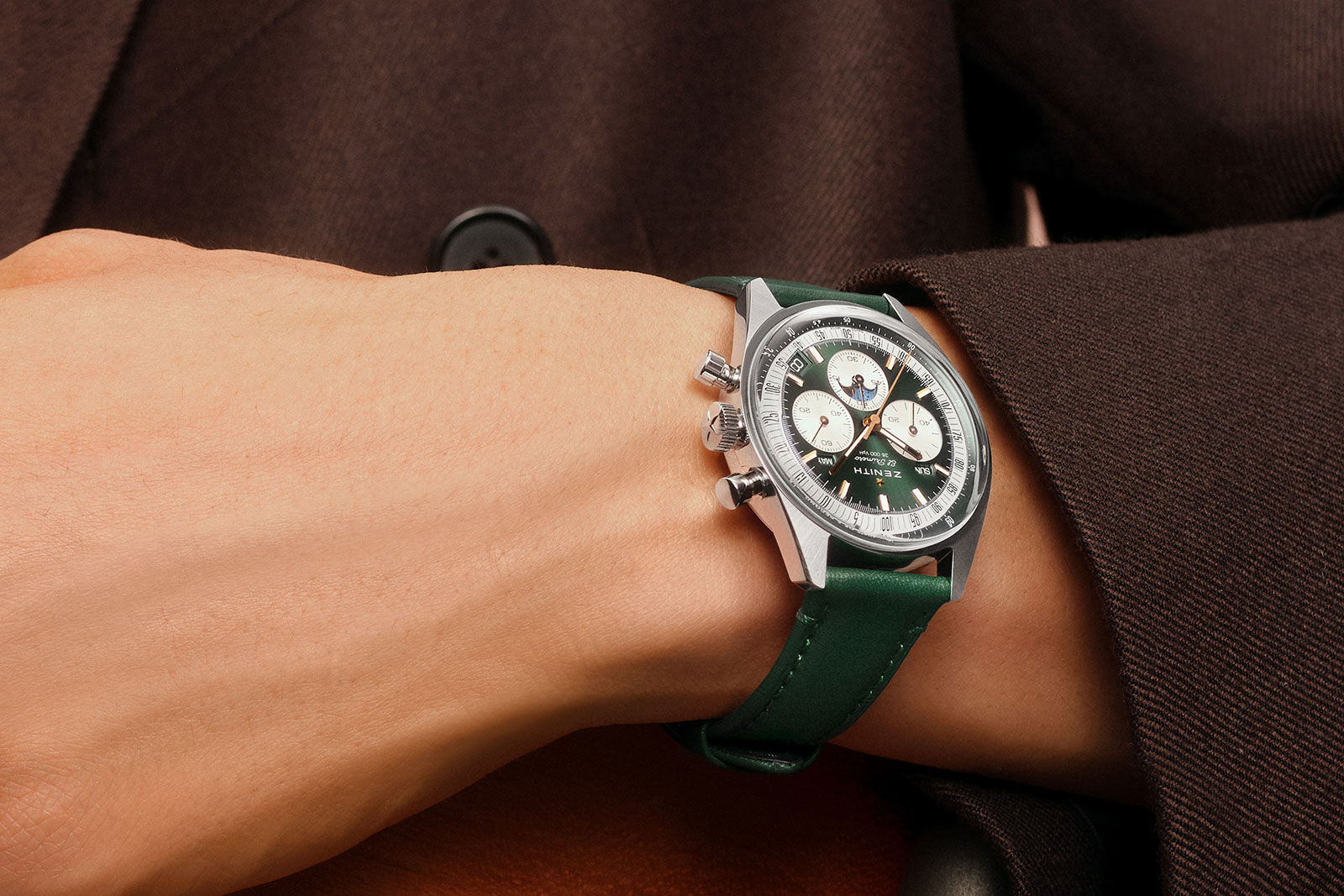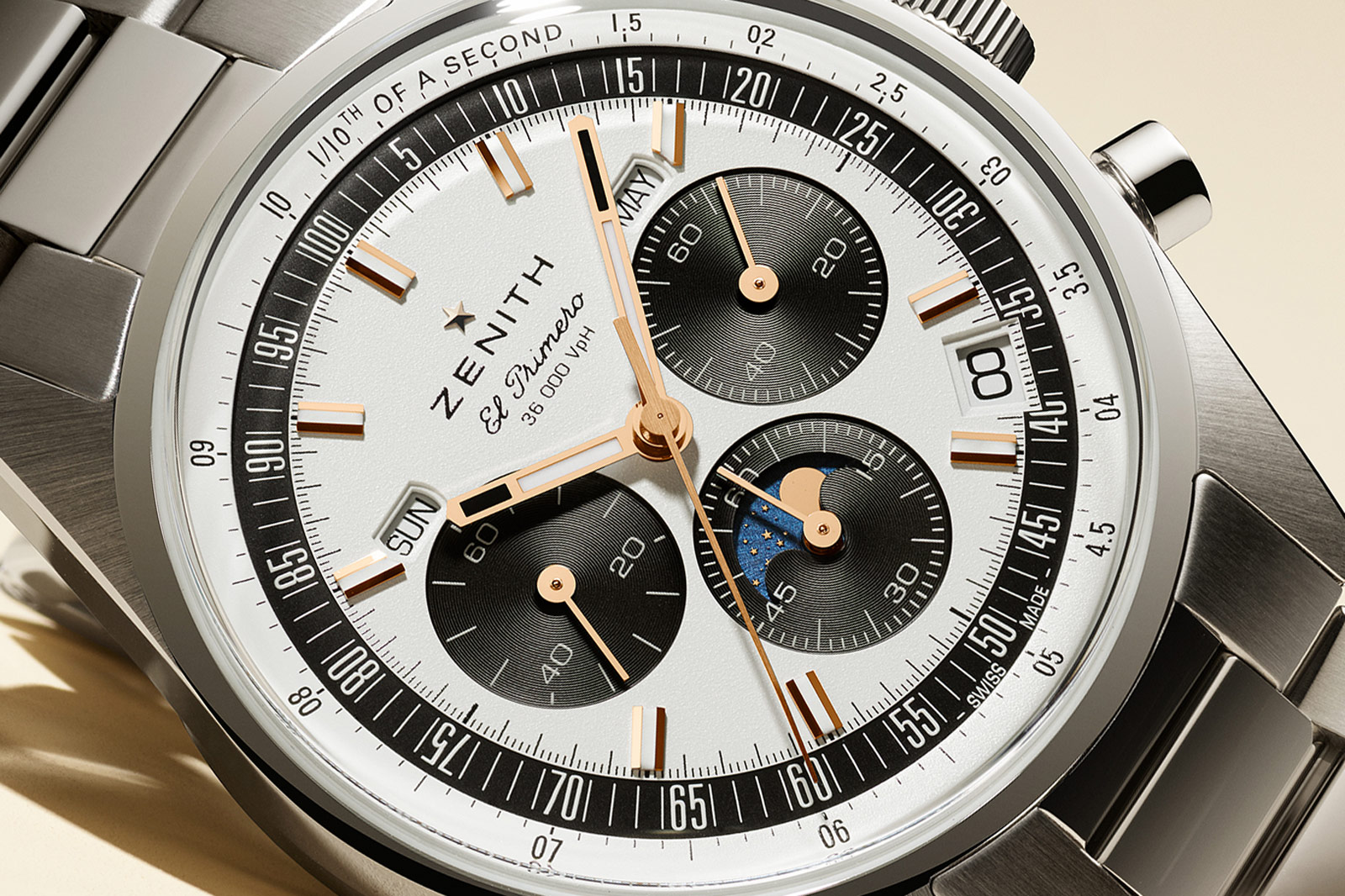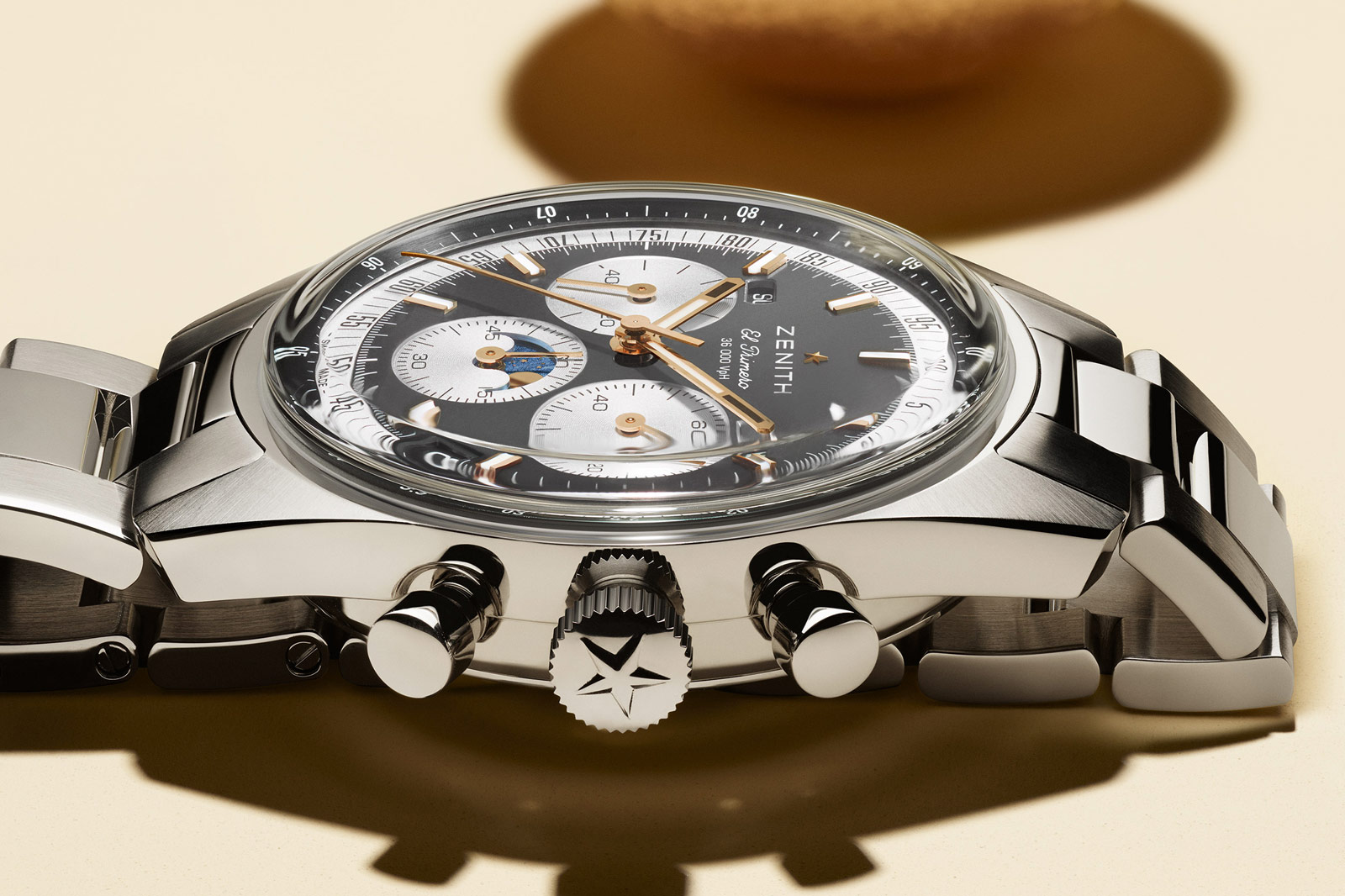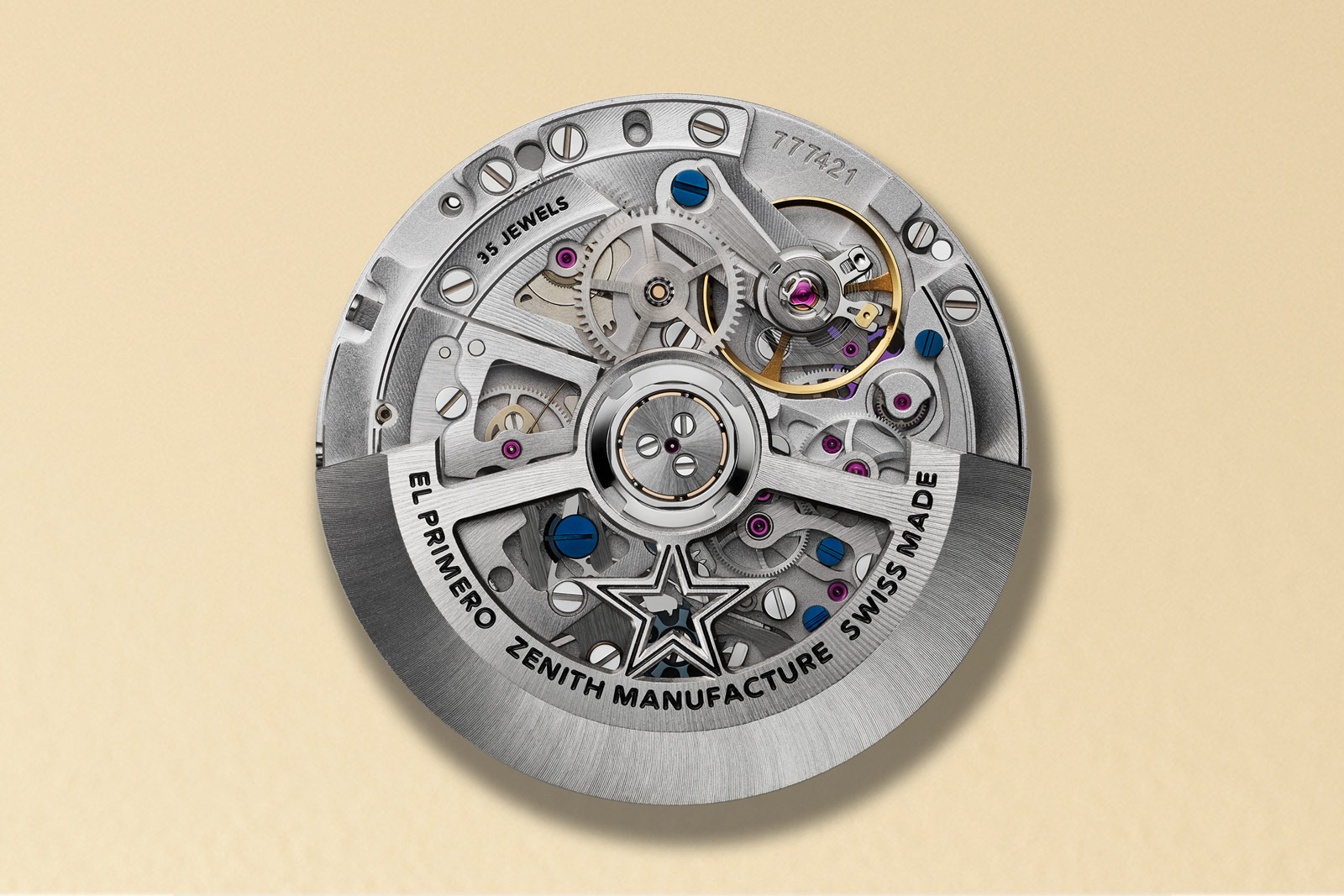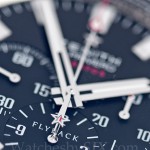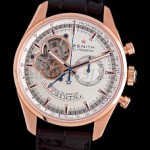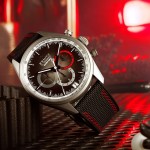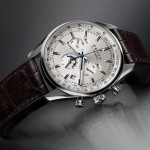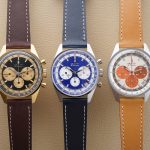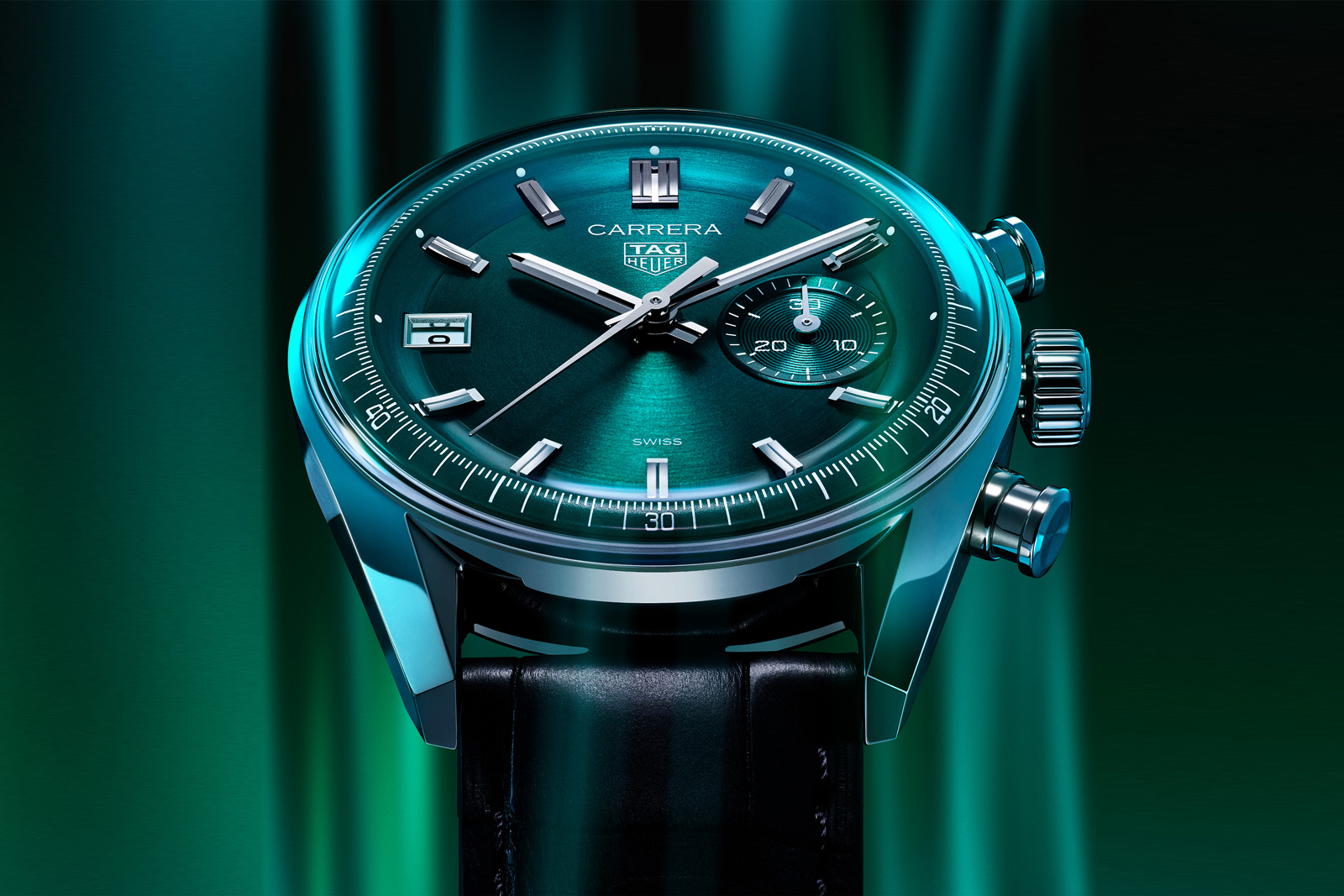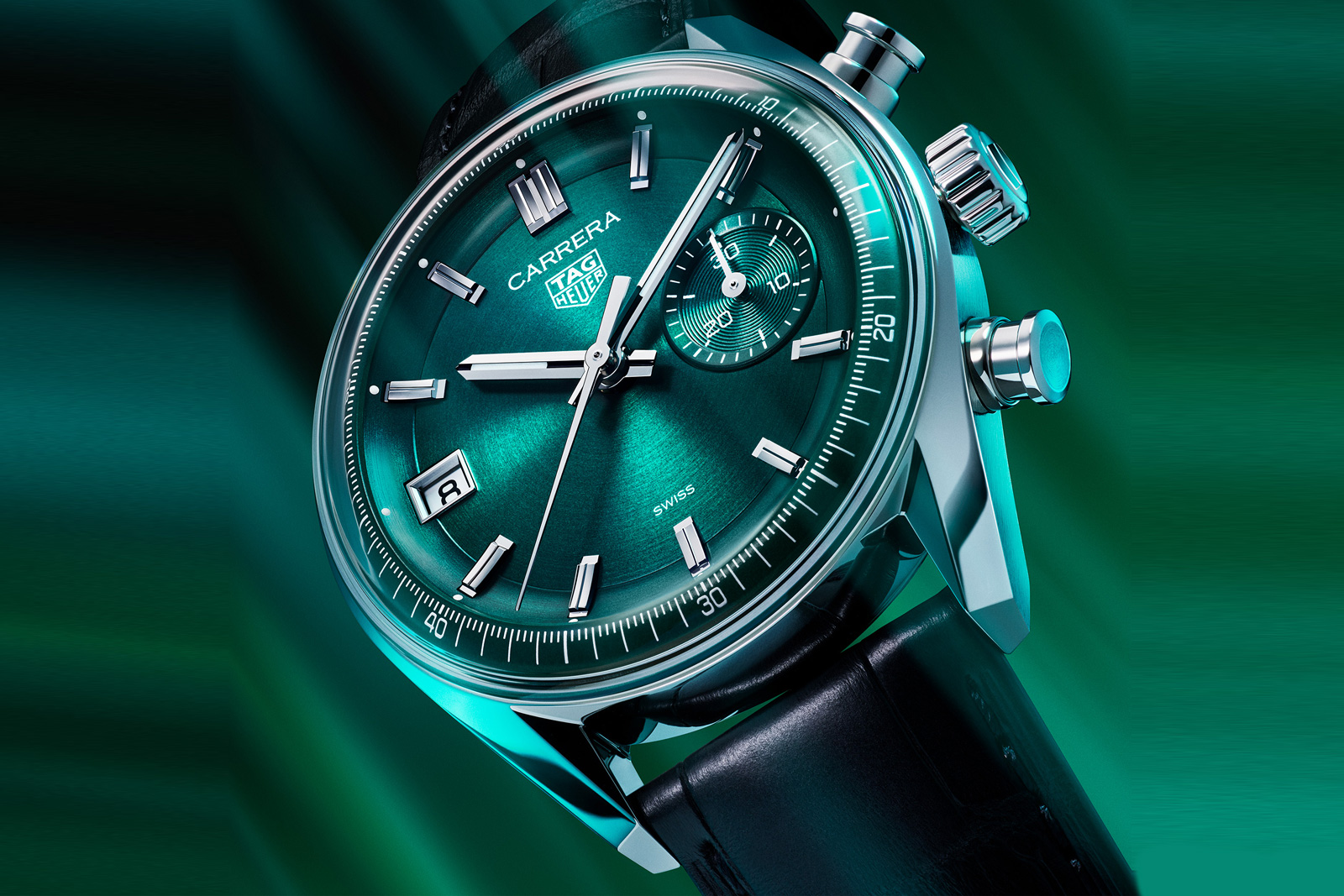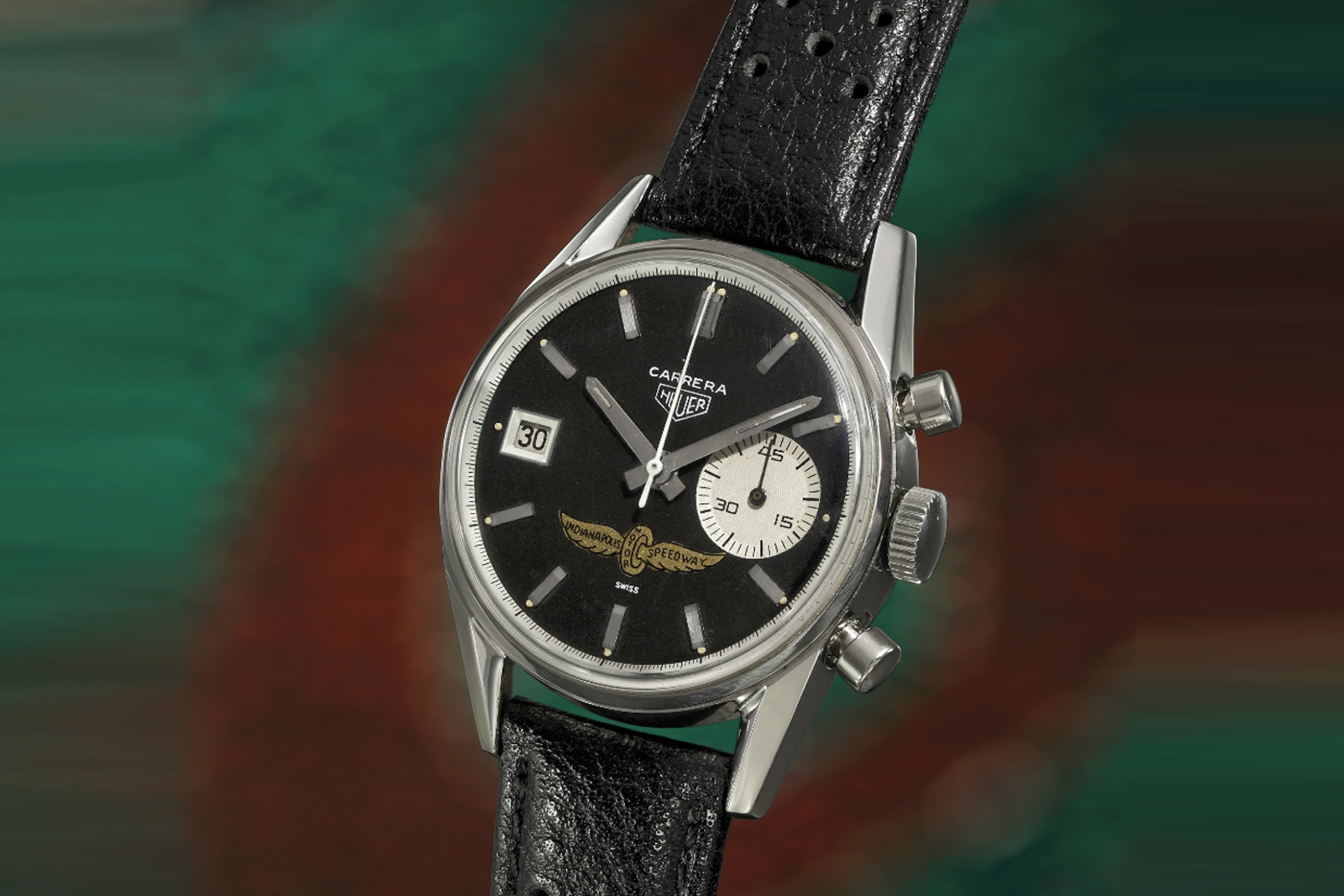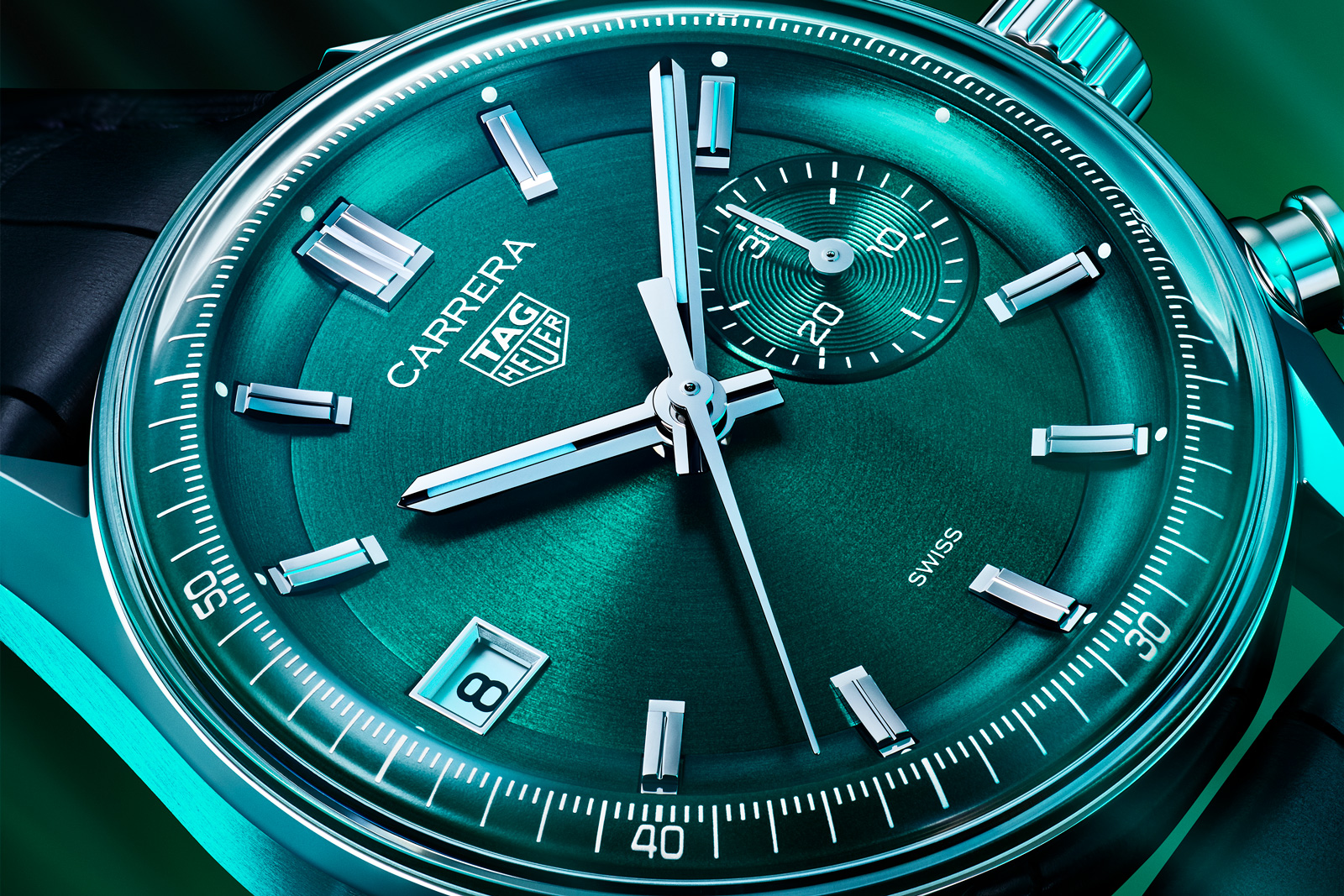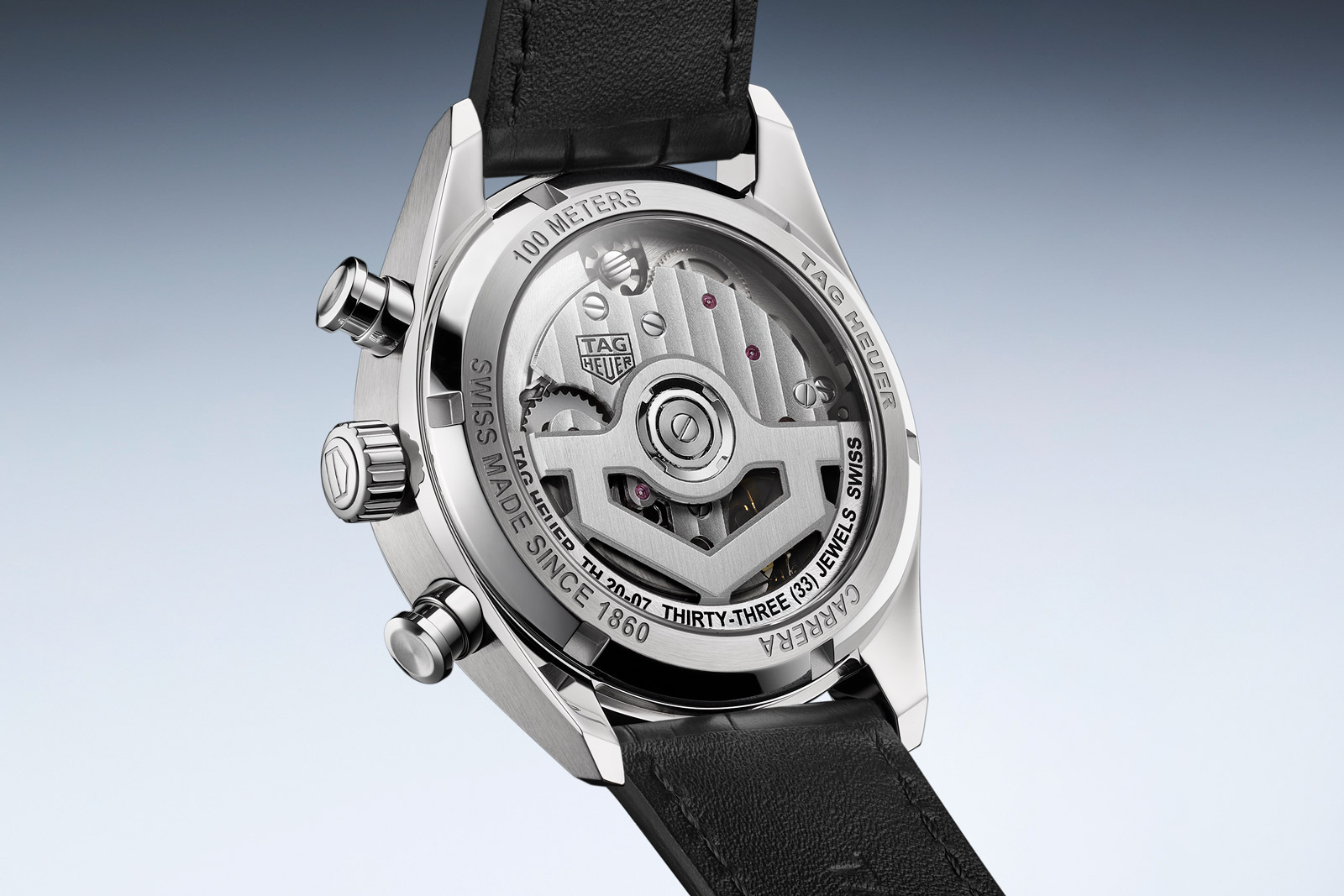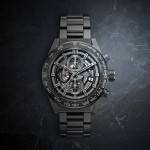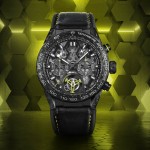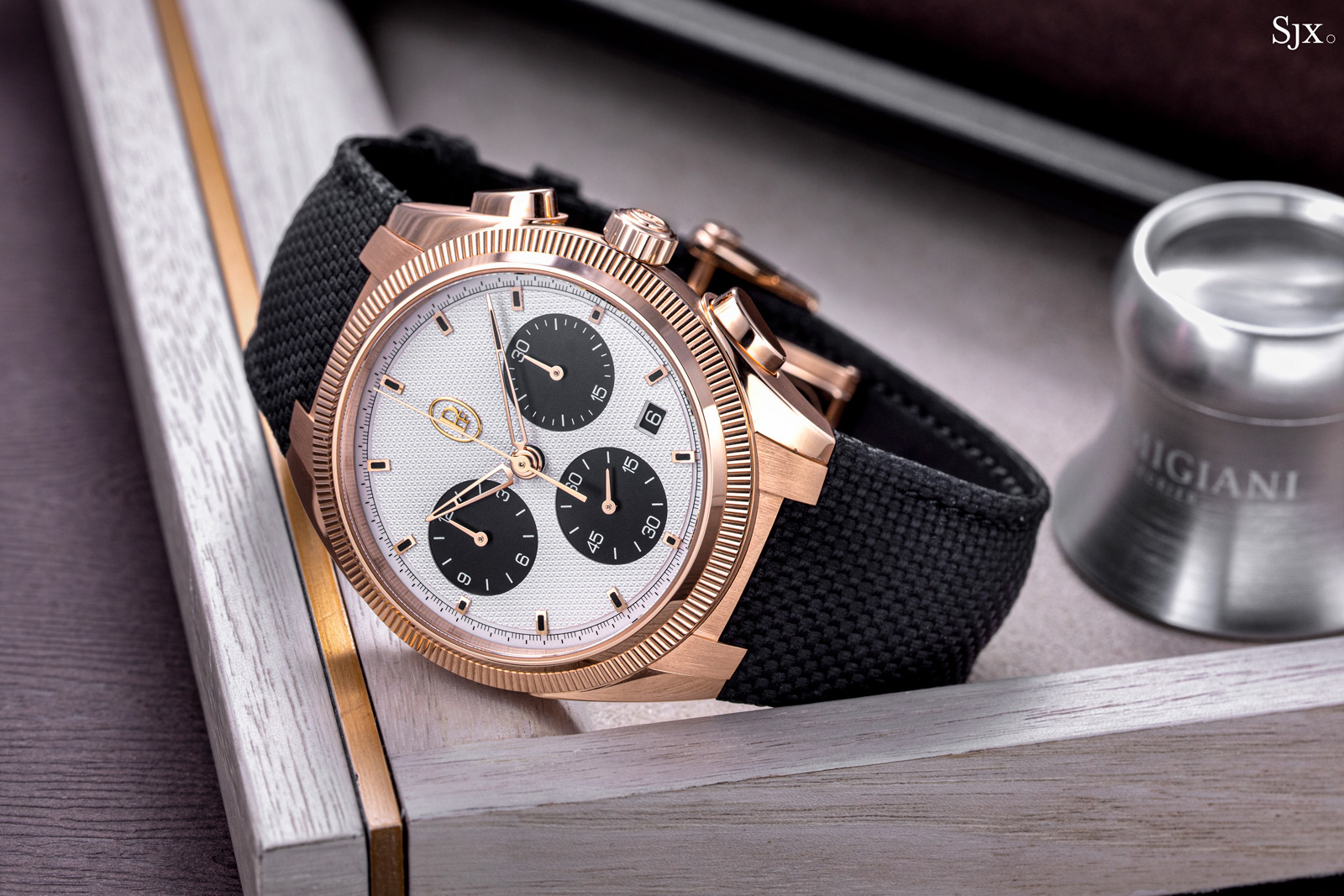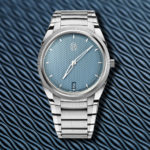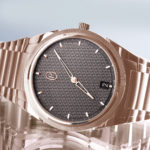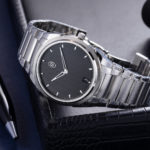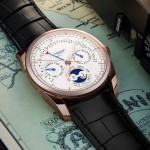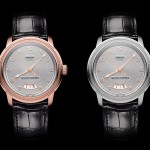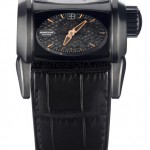Two years after the Tonda PF, a commercial hit for the previously low-key brand, Parmigiani Fleurier has diversified its lineup of sports watches with the Tonda PF Sport. Replacing the Tonda GT as the brand’s entry-level sports watch, the Tonda PF Sport has a cleaner, bolder aesthetic compared to the Tonda PF.
The Tonda PF Sport is available as either a chronograph, or a time-and-date automatic. The standout model is the Tonda PF Sport Chronograph, which is equipped with the PF070, an integrated chronograph movement with impressive features, including a high-frequency, free-sprung balance running at 36,000 beats per hour (5 Hz), double barrels, as well as the requisite column wheel and vertical clutch expected of a modern calibre – all contained in a package under 7 mm high.
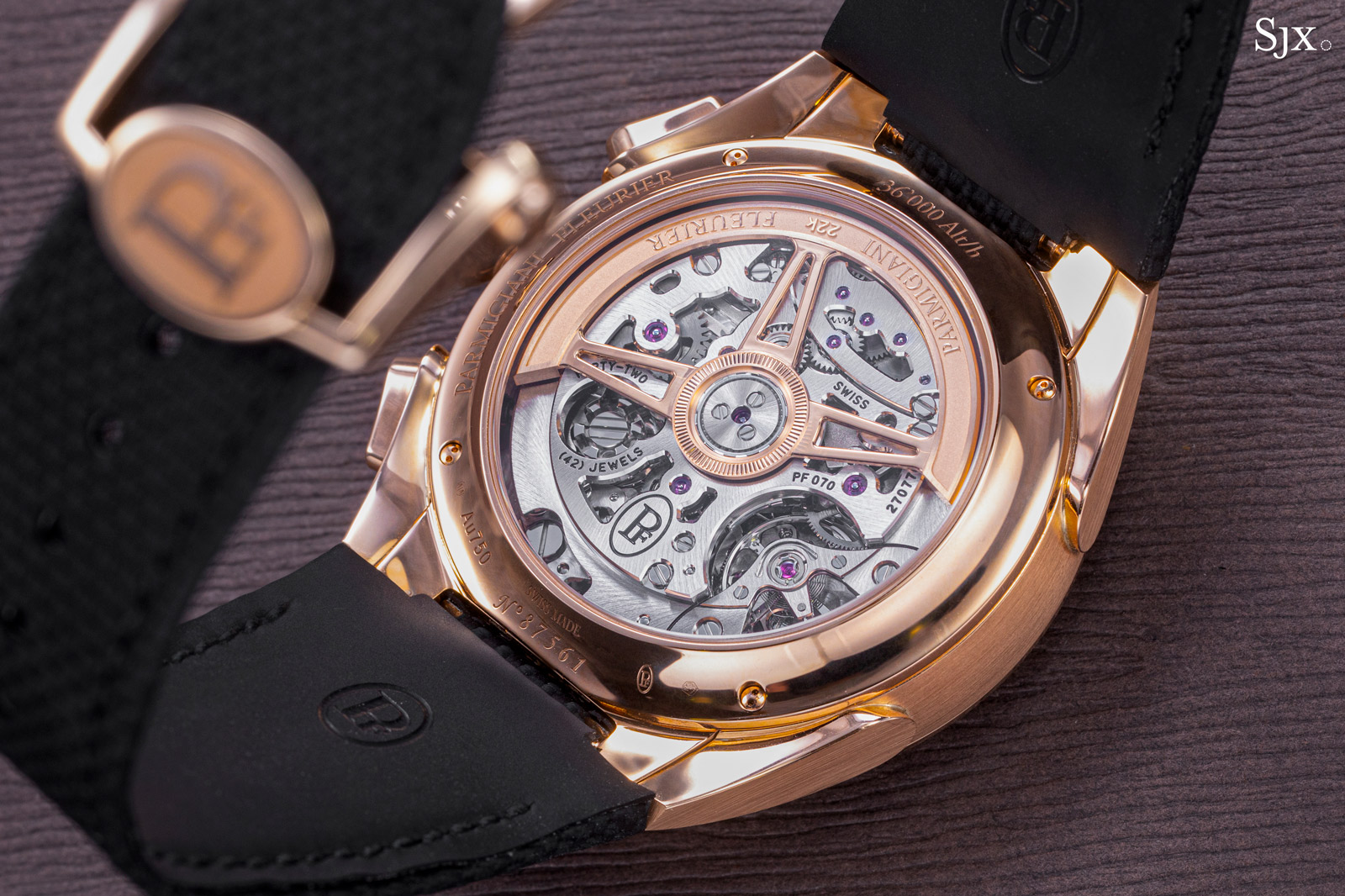
Initial thoughts
My first in-person encounter with Parmigiani’s sports watch was in 2021 when the brand launched the Tonda PF amidst the integrated-bracelet-sports-watch craze during the pandemic. Countless brands were trying to replicate the success of the Royal Oak and Nautilus, so it seemed like Parmigiani was just one of many trying to do the same thing.
However, when I got an opportunity to examine the Tonda PF in person during Geneva Watch Days that year, it struck me as something different, rather than a derivative product. Even though the Tonda PF was clearly an integrated-bracelet sports watch, it was not like the others in both style and detail.
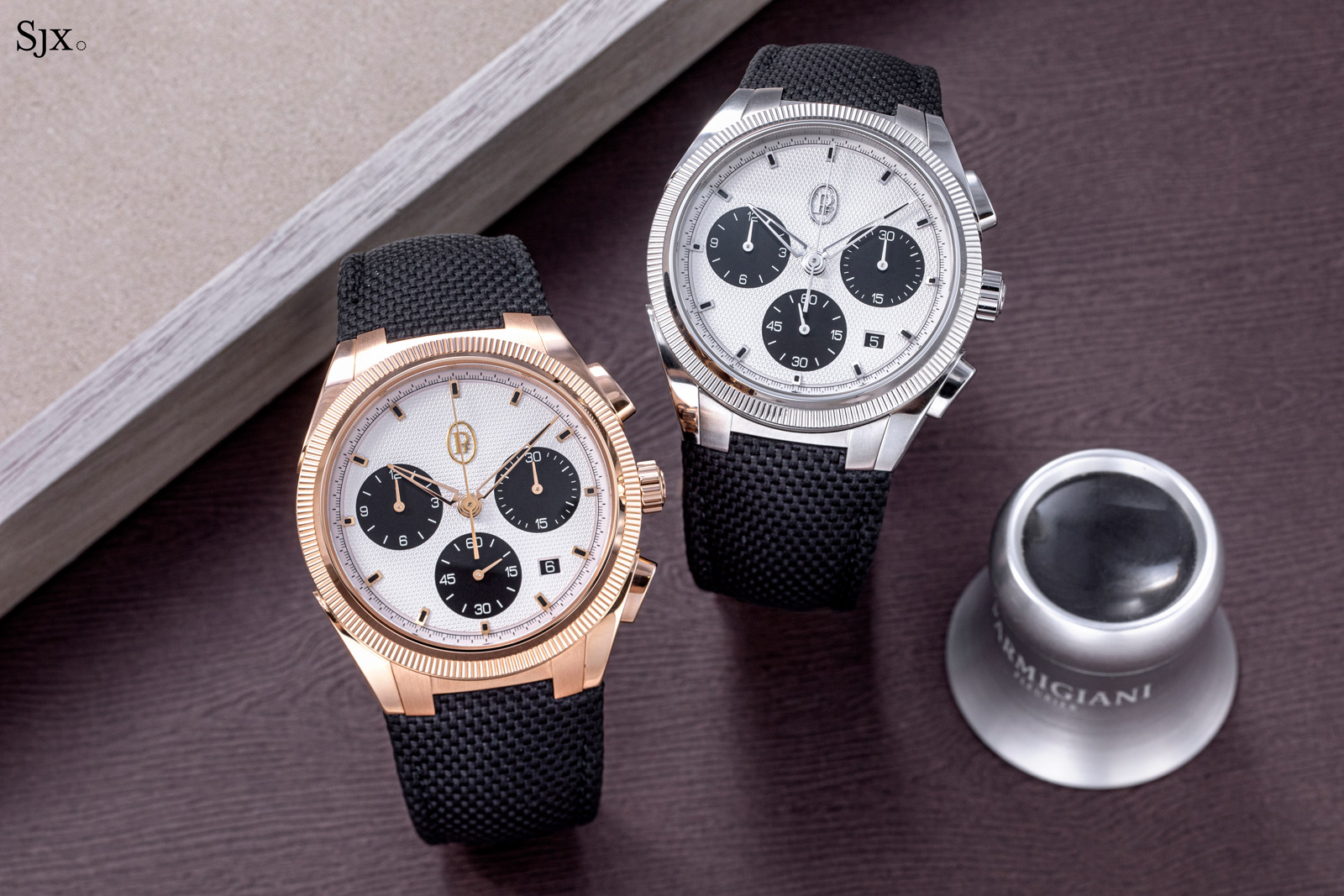
The Tonda PF Sport Chronograph is obviously a continued expansion of Parmigiani’s sports watch project; it doesn’t look much different from the Tonda PF Chronograph. Although similar to its cousin, the Tonda PF Sport is clearly a different watch.
The minimalist design has been preserved, but design tweaks like a “panda” dial and wider hands give it a bolder and more informal aesthetic. The case is also imperceptibly thicker, which adds to its more modern feel.
And as with most things luxury, it is the details that set the Tonda PF Sport apart. The dial guilloche, for instance, is done by hand on a traditional machine. And it’s fitted to a rubber strap that is not conveniently injection moulded as is common, but one padded and stitched like a leather strap.
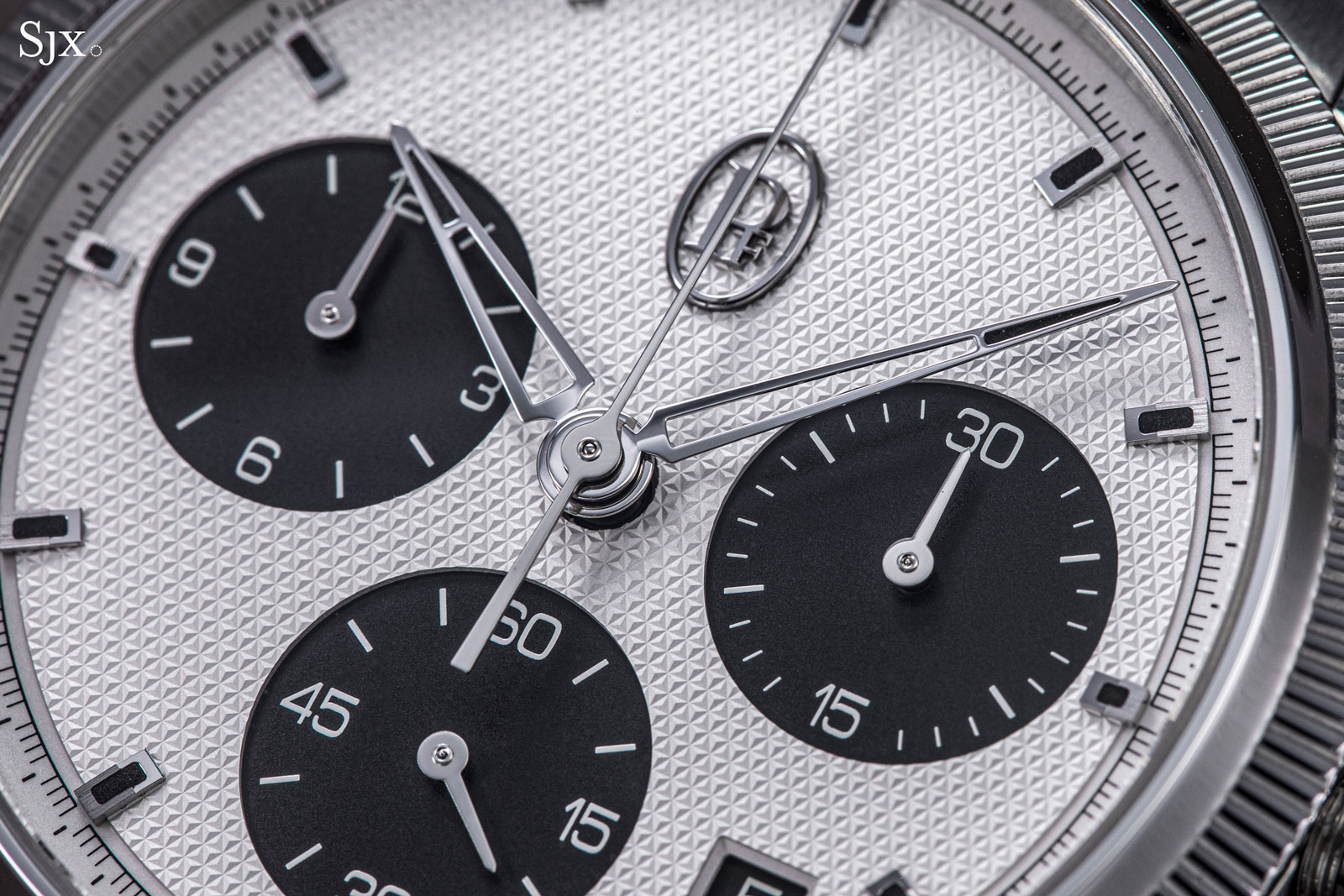
However, in mechanical terms, the PF Sport and PF are essentially identical, both share the same integrated PF070, albeit with a different rotor. Notably, both the steel and gold versions of the PF Sport feature the PF070. This is a major upgrade as the outgoing Tonda GT it replaces contained a modular movement for the steel model, and only the gold version featured the integrated movement.
The Tonda PF Sport costs about 10% less than the Tonda PF, which might lead some to label it as an affordable alternative. However, the difference between the retail prices of the two isn’t great enough to justify this characterisation, since the PF Sport is delivered on a strap while the PF is on a bracelet as standard. And adding a bracelet to the PF Sport brings its total cost to slightly above that of the PF.
Rather than an affordable alternative, I see the Tonda PF Sport Chronograph as the sportier sibling of the Tonda PF. Both in terms of look and feel, it feels like a sportier, gently bulked up watch. Even the crown is larger on the PF Sport than the PF.
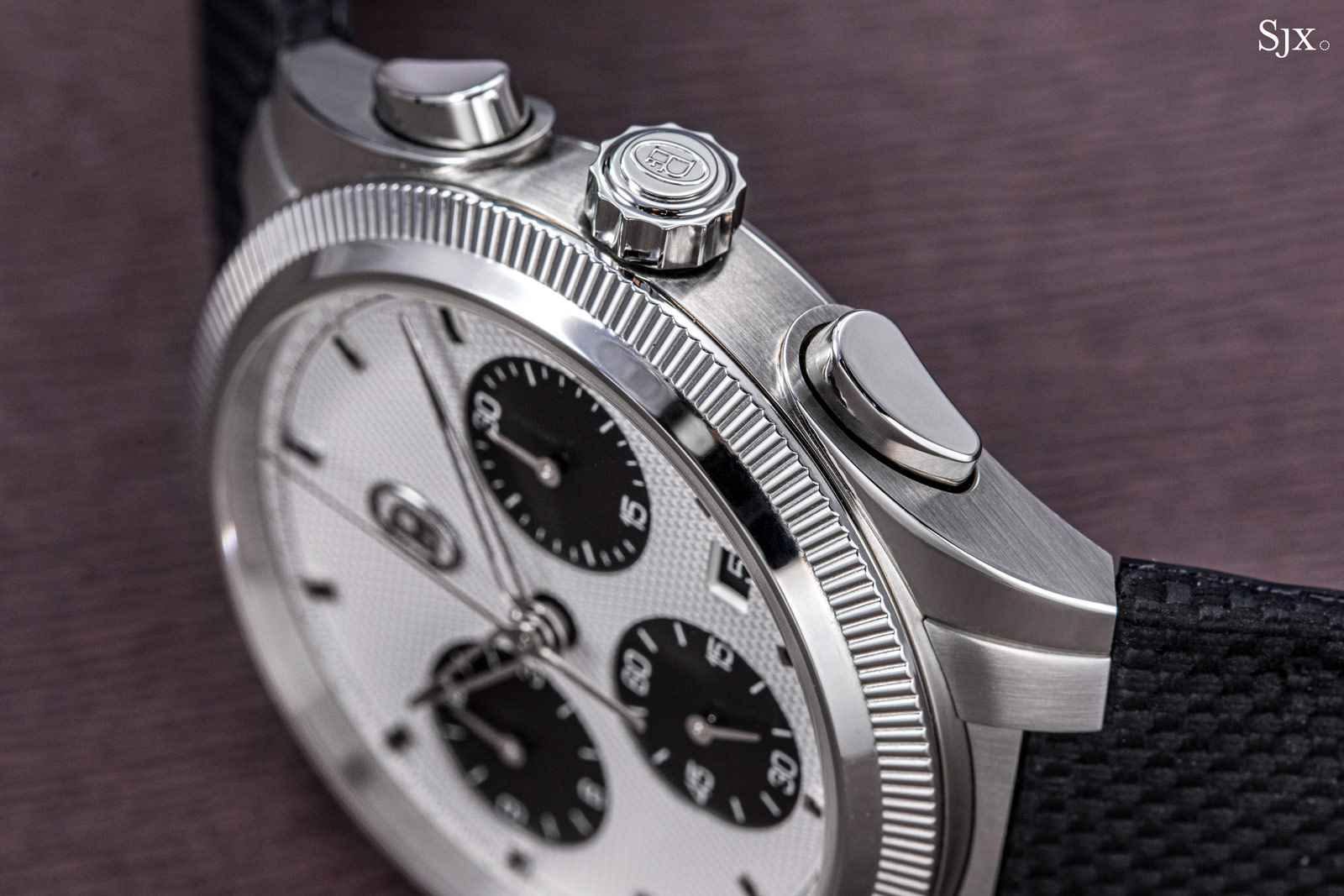
In terms of the value proposition, the Tonda PF Sport would make sense for someone who prefers a strap instead of a bracelet, and wants something sportier. Conversely, the Tonda PF Chronograph arguably gives more bang for the buck because for 10% more in the steel version, it includes a platinum bezel and matching bracelet.
Relative to the wider market, the Tonda PF Sport costs about a fifth less than the most obvious competitors, namely the Audemars Piguet Royal Oak and Vacheron Constantin Overseas. While both have more elaborate cases in terms of design and finishing – and certainly more brand recognition – the Tonda PF Sport brings with it a superior movement that boasts a sophisticated construction and excellent finishing.
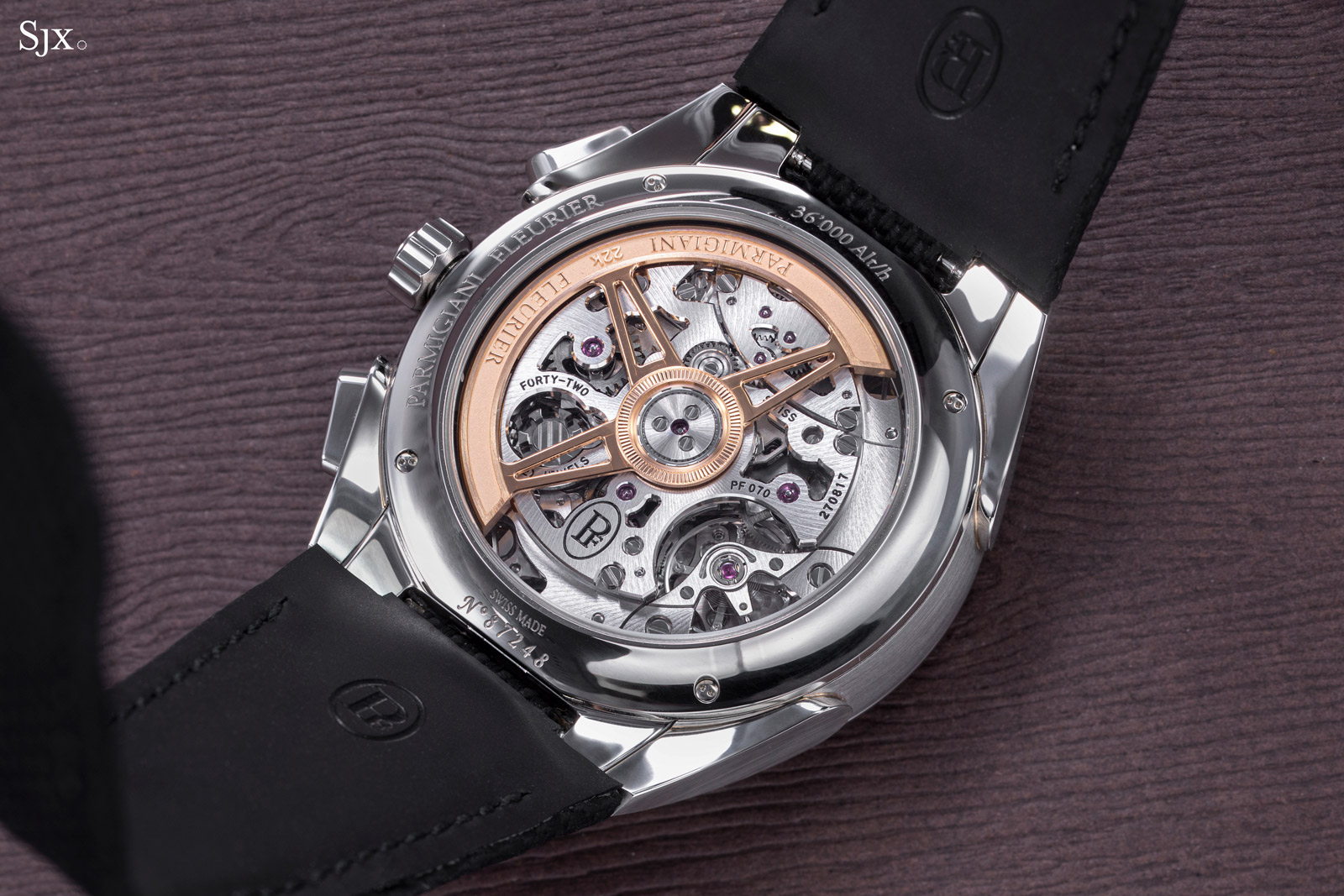
The cal. PF070/6710
The biggest strength of the Tonda PF Sport is its movement, the in-house PF070/6710, which is one of the most sophisticated chronograph movements found in a luxury-sports watch The calibre is essentially identical to the PF070, with the “6710” suffix referring to the rotor. Modelled on the steering wheel of the Ferrari 250 GTO, the rotor is 22k rose gold and unique to the Tonda PF Sport.
Whereas the outgoing Tonda GT was kitted out with a modular movement, the PF070 is an integrated movement, meaning it was engineered from the ground up as a chronograph calibre. Evidently conceived to be a high-performance chronograph that draws best-in-class movements for inspiration, the PF070 is a typical chronograph movement in that it utilises a vertical clutch and column wheel, both now standard in modern calibres.
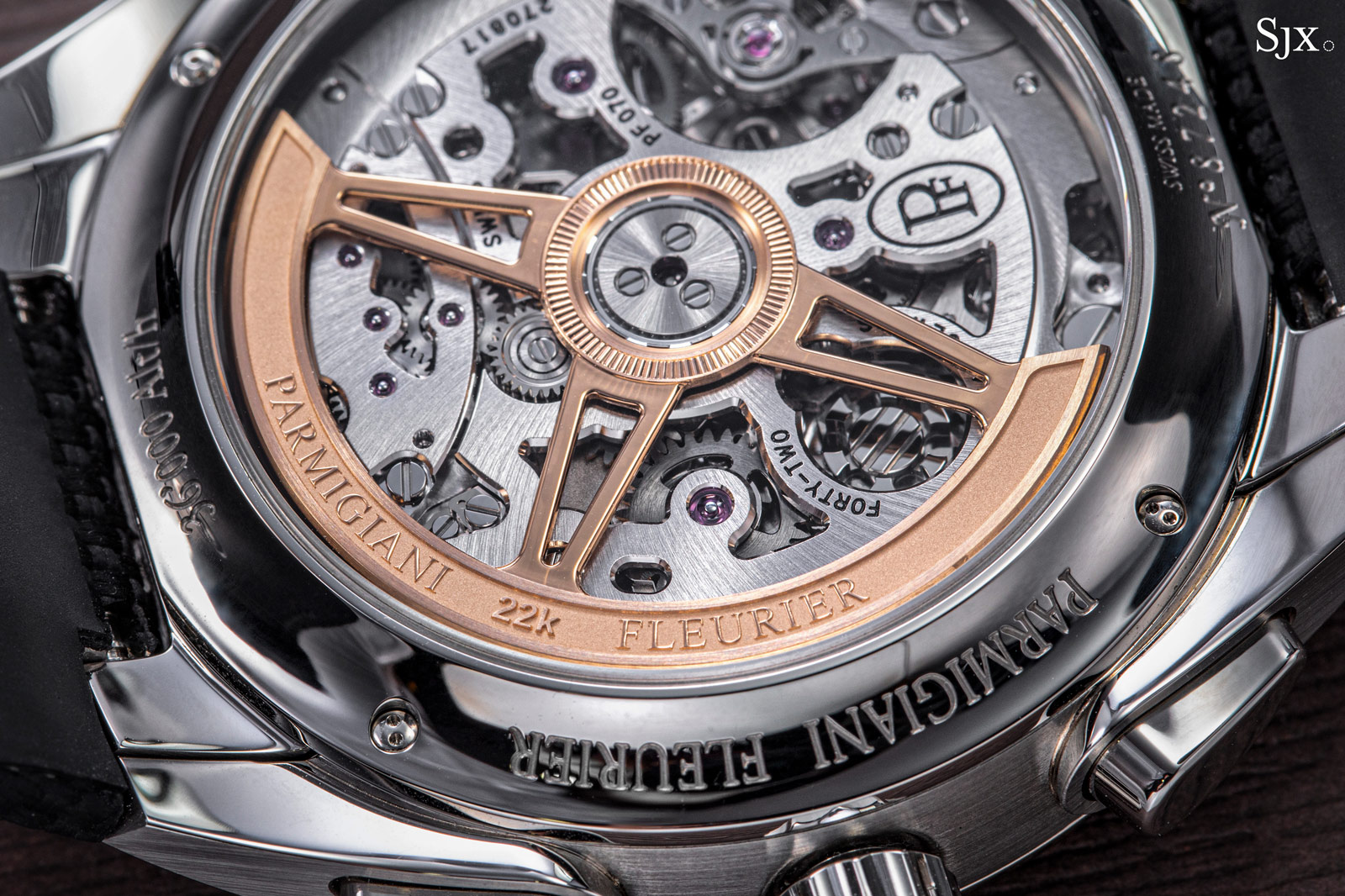
The advantages of each are well known. The vertical clutch optimises energy consumption while the chronograph is engaged, while also eliminating the seconds hand “stutter” that occasionally accompanies a laterally-coupled chronograph. And the column wheel offers a more precise and consistent pusher action for the start, stop, and reset functions.
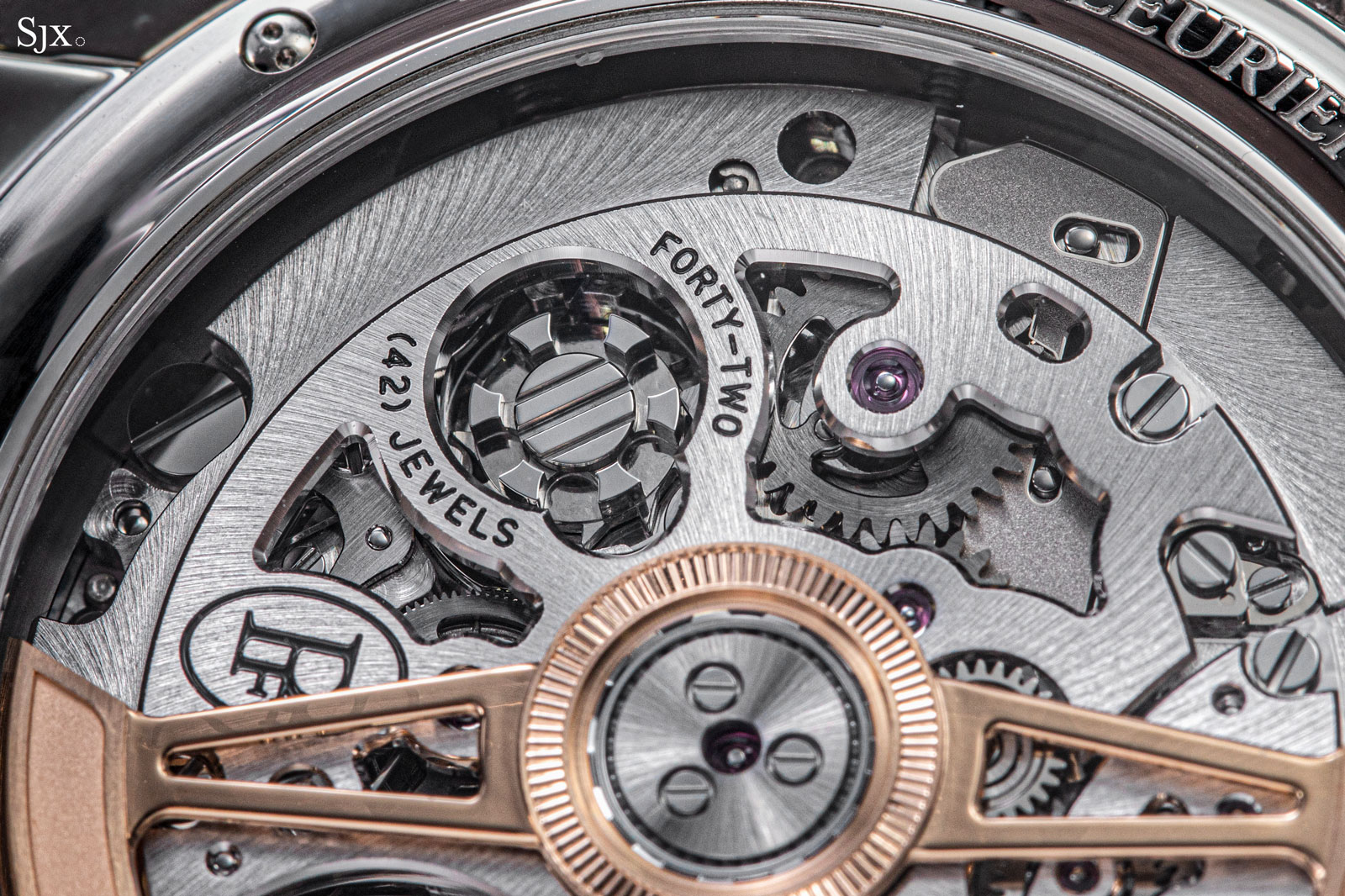
More unusual is the fact that it is a high-frequency movement with a balance that oscillates at 5 Hz, or 36,000 beats per hour. The balance is of course free-sprung, and also secured by a full bridge, a feature particularly suited to sports watches for its stability.
All things being equal, a high-frequency balance is more stable over time, but requires additional energy to operate. Oftentimes that leads to a compromise of either a smaller balance or shorter power reserve. However, here the 5 Hz balance is complemented by double barrels that unwind in series, or one after another, a set-up that delivers sufficient and consistent torque over its running time, which is a respectable 65 hours.
Beyond timekeeping stability, the 5 Hz balance is particularly suited to a chronograph, since it allows for measurements of elapsed times of up to 1/10th of a second, a more intuitive division of time than say, 1/8th of a second. This explains the five hashmarks per second on the outermost scale of the dial, with each hashmark corresponding to 1/5th or 2/10th of a second.
The PF070 is also thin at 6.95 mm high. Most automatic chronograph movements are over 7 mm high, and most thinner chronograph calibres under 7 mm feature single barrels and lower frequency balances.
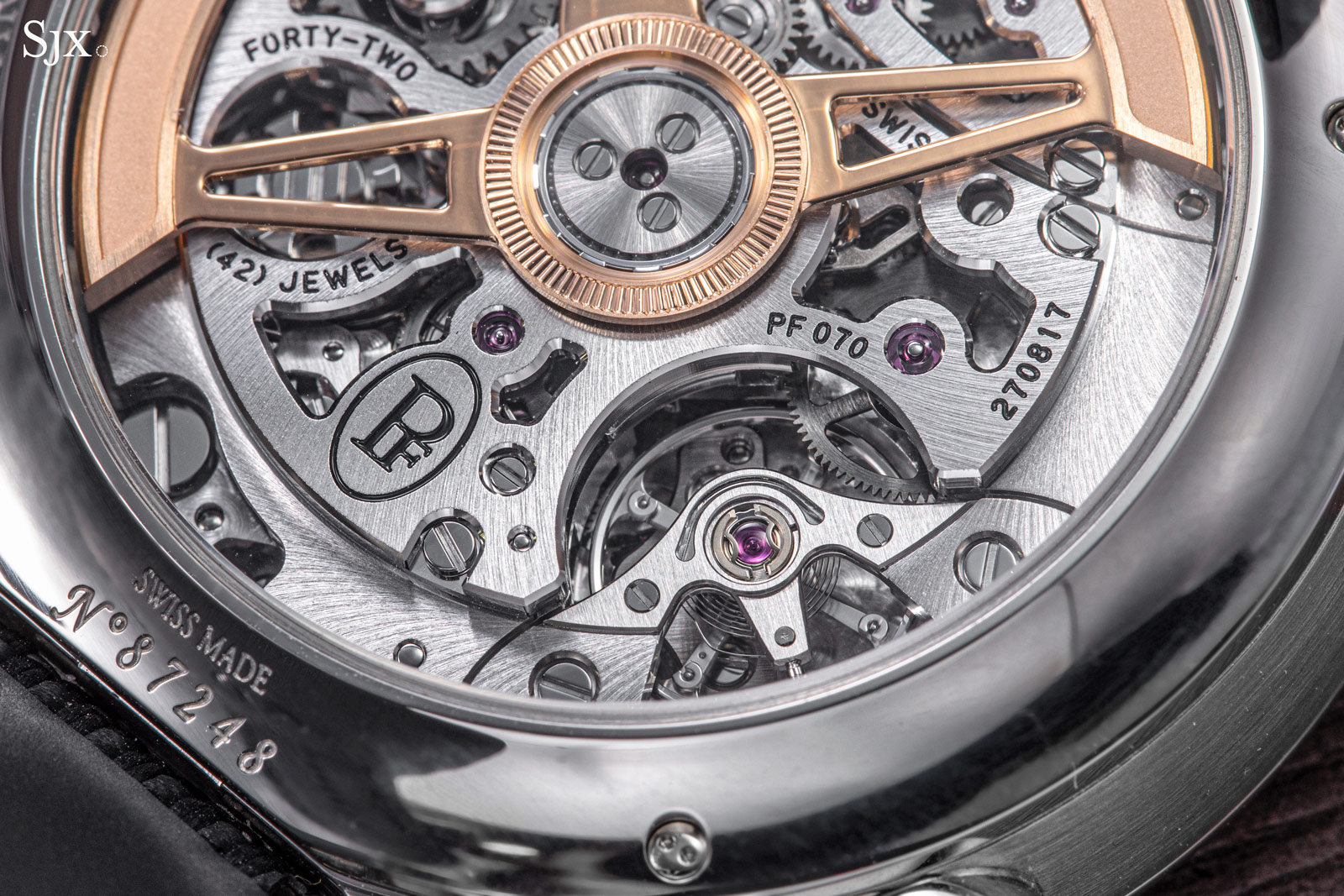
The decoration of the movement is a high-quality industrial finish akin to that found in comparable chronograph movements from Audemars Piguet and H. Moser & Cie.
Finished with a radial graining, the bridges are outlined by wide, precisely milled bevels along their edges. Because the bridges have been open-worked to reveal the wheels within, the bevelling is not only on the outer edges but the inner edges as well, which gives the movement an intricate, mechanical appearance.
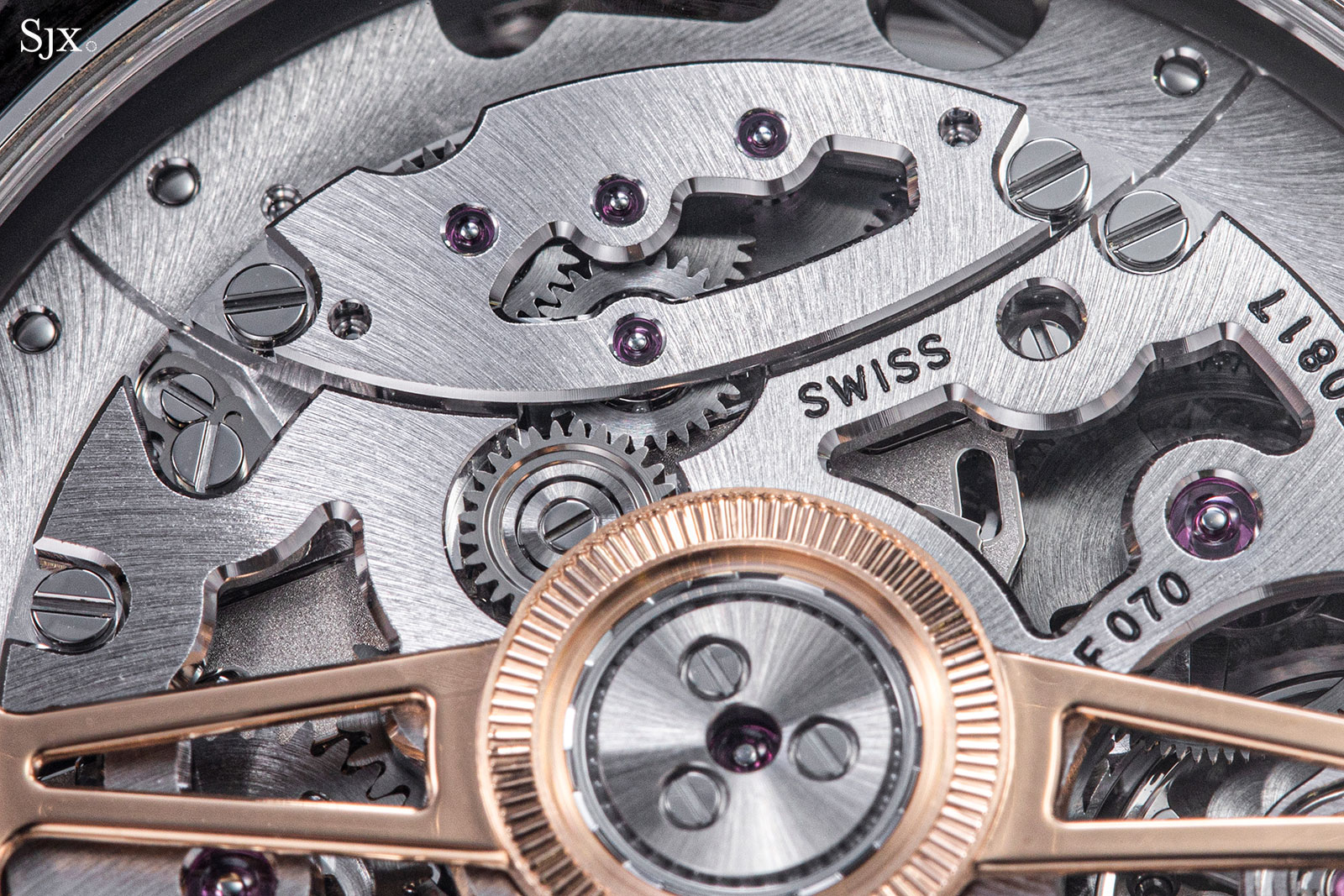
But the quality of the movement is arguably more evident in the less obvious details that are equally well attended to, for instance the polished screw heads that have chamfered slots and edges, as well as the polished tops of the pins visible on the base plate. All of the wheels, including those partially hidden by the bridges, sport concentric graining, as well as the occasional chamfered inner edge.
As an aside, artisanal decoration is feasible for this calibre, but at a price. The PF361 inside the Tonda PF Split Seconds is essentially the same movement but minus the automatic winding mechanism and with the addition of a rattrapante. As a result the PF361 has a similar aesthetic and architecture, but with hand-applied decoration on all components, explaining why the split-seconds in gold is four times more expensive than the PF Sport in the same metal.
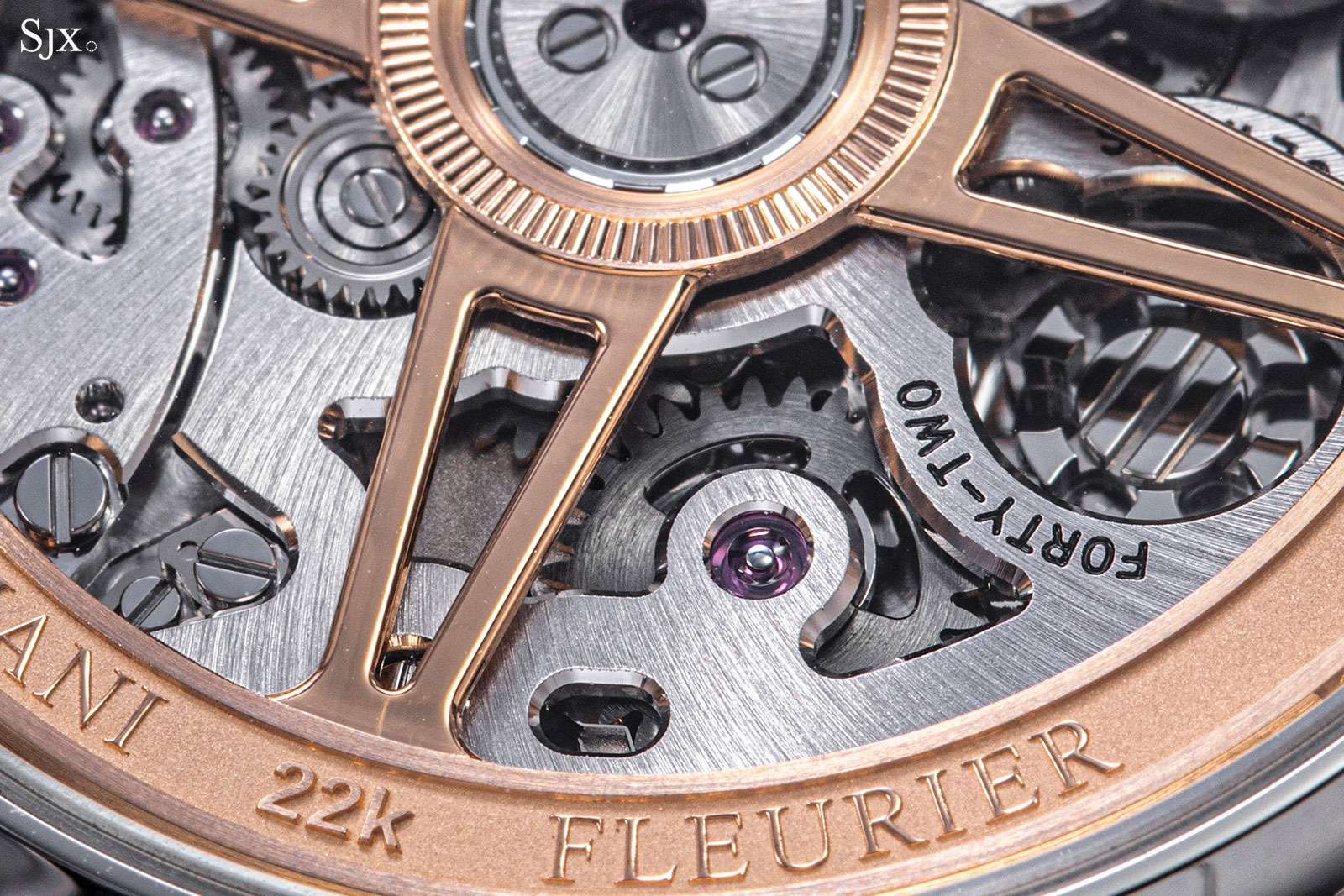
A subtle redesign
The styling of the Tonda PF Sport Chronograph continues with the aesthetic established by the Tonda PF, which was itself derived from the Tonda, a round dress watch that was part of Parmigiani’s catalogue for more than a decade. The brand successfully transformed a dress watch into a sports watch, retaining the elegance of the design while giving it the wide and flat proportions that define most luxury sports watches.
The PF Sport’s case is 12.9 mm high, making it slightly thicker than the PF that is 12.4 mm. Both are thinner than the Tonda GT Chronograph, which was 13.7 mm in steel due to the height of the modular movement. Even though the case has increased in thickness over the PF, the difference is not apparent except when comparing both in detail side by side. The 12.9 mm case still gives the PF Sport a relatively slim profile for a large-diameter sports chronograph. And with the slightly taller case, the Tonda PF Sport is appropriately fitted with a larger crown than the Tonda PF.
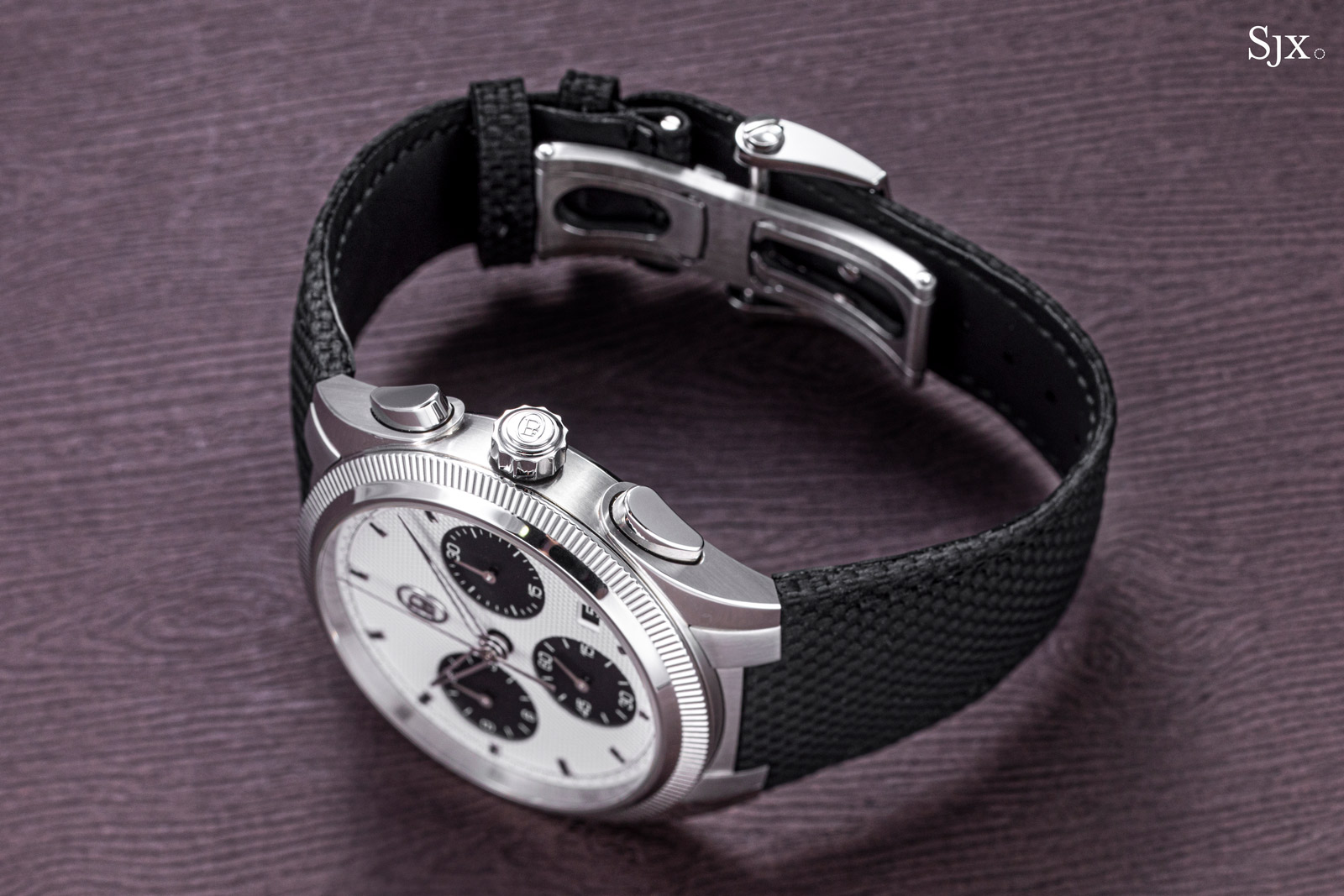
As with the original Tonda, the defining feature of the Tonda PF Sport Chronograph are the wide lugs. The size of the lugs are the key element in the sporty stance of the overall design. However, the lugs are purposefully kept short, which allows the case to hug the wrist, making it more wearable than the 42 mm diameter would otherwise imply. As a result, it is easily wearable for even medium-sized wrists such as mine (my wrist size is 6.5″ for reference).
The lugs are striking not just for their size, but the level of detail visible in their multi-layered form and finishing. Each lug is essentially a two-part, stepped affair with contrasting brushed and polished surfaces – a detail only visible upon close inspection – which was achieved by fabricating and finished each section individually before soldering the lugs into the case. Soldered lugs are typically associated with finely wrought dress watches with thin lugs, so it is notable that the same process was employed here to achieve a different aesthetic yet one with similar level of detail.
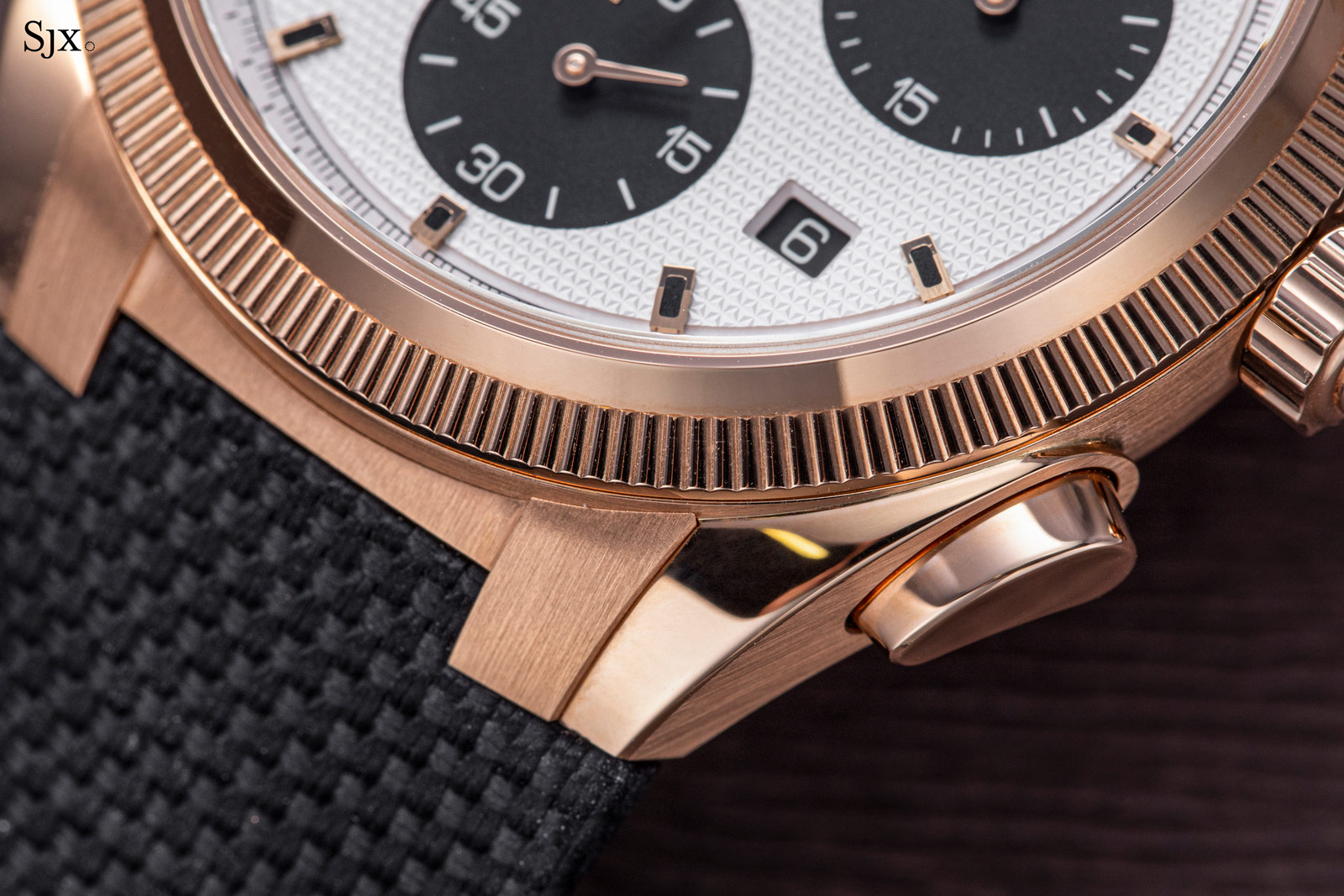
A notable example of the attention to detail in the design lies in the chronograph pushers that echo the tear-drop profile of the lugs, seamlessly integrating them into the case aesthetic
The second key element of the design is the knurled bezel, which is common to both the Tonda PF Sport and the Tonda PF. The execution, however, is different: the step; bezel on the PF Sport is knurled to feature 160 flutes, rather the 225 on the PF’s platinum bezel. Fewer flutes mean each is wider, which makes the bezel more prominent and accentuates the sporty nature of the design.
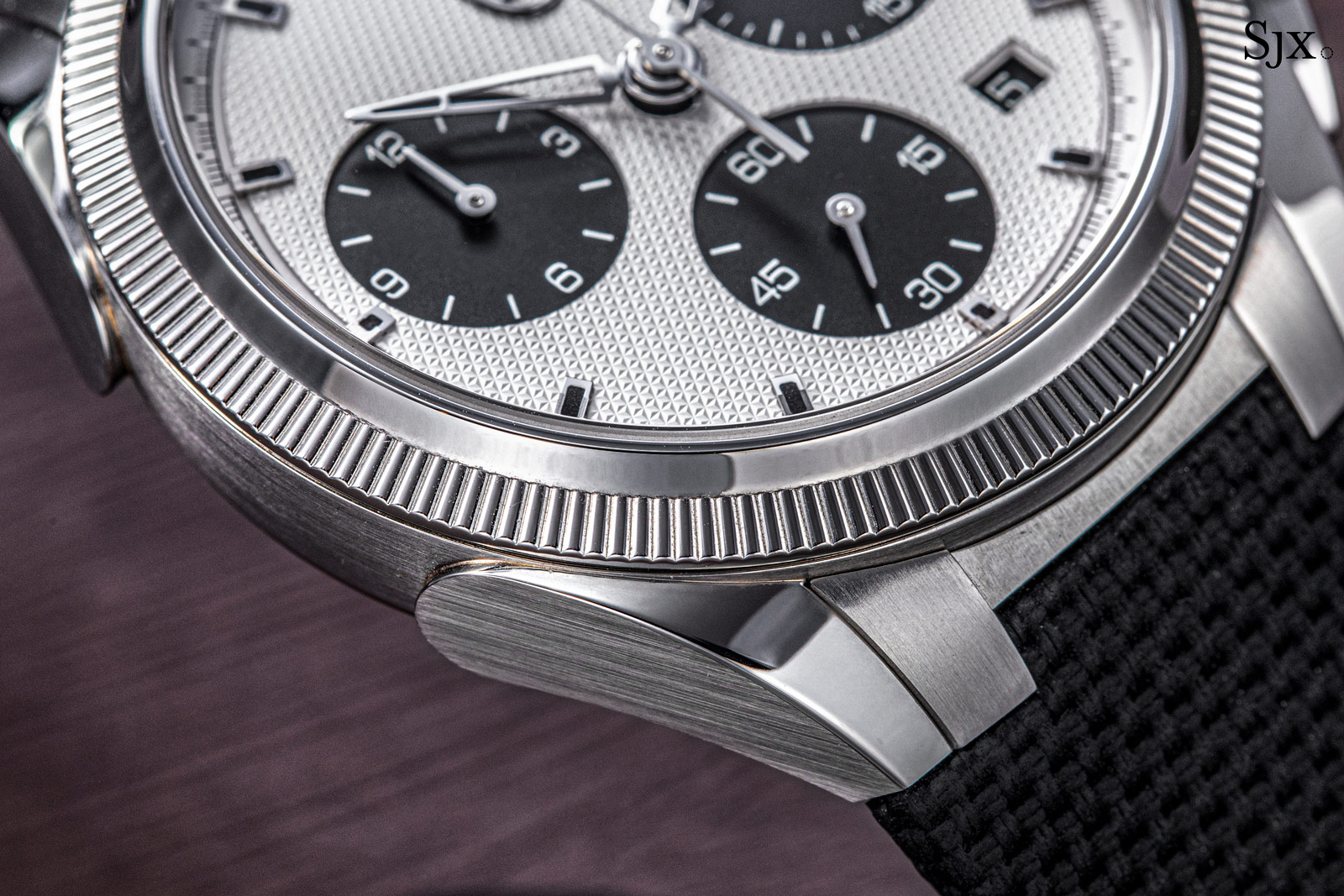
The dial of the Tonda PF Sport retains the familiar styling first seen on the Tonda PF. And because the movement inside is the same, the layout is identical. However, the dial is now a “panda” – silver with matte-black registers – a combination traditionally associated with sports watches, specifically auto-racing chronographs. Although the “panda” livery is derived from the earlier Tonda GT “Panda”, the Tonda PF Sport adopts the minimalist approach of the Tonda PF, and avoids the over-designed feel of the GT.
The date window sticks to the “panda” aesthetic with a contrasting black date wheel against the silver dial. In contrast, the PF utilises a tone-on-tone date wheel that blends in. This is the only aspect of the dial that I would change. I would have preferred either a discreet silver date wheel or placing the black date display within the minute counter at six.
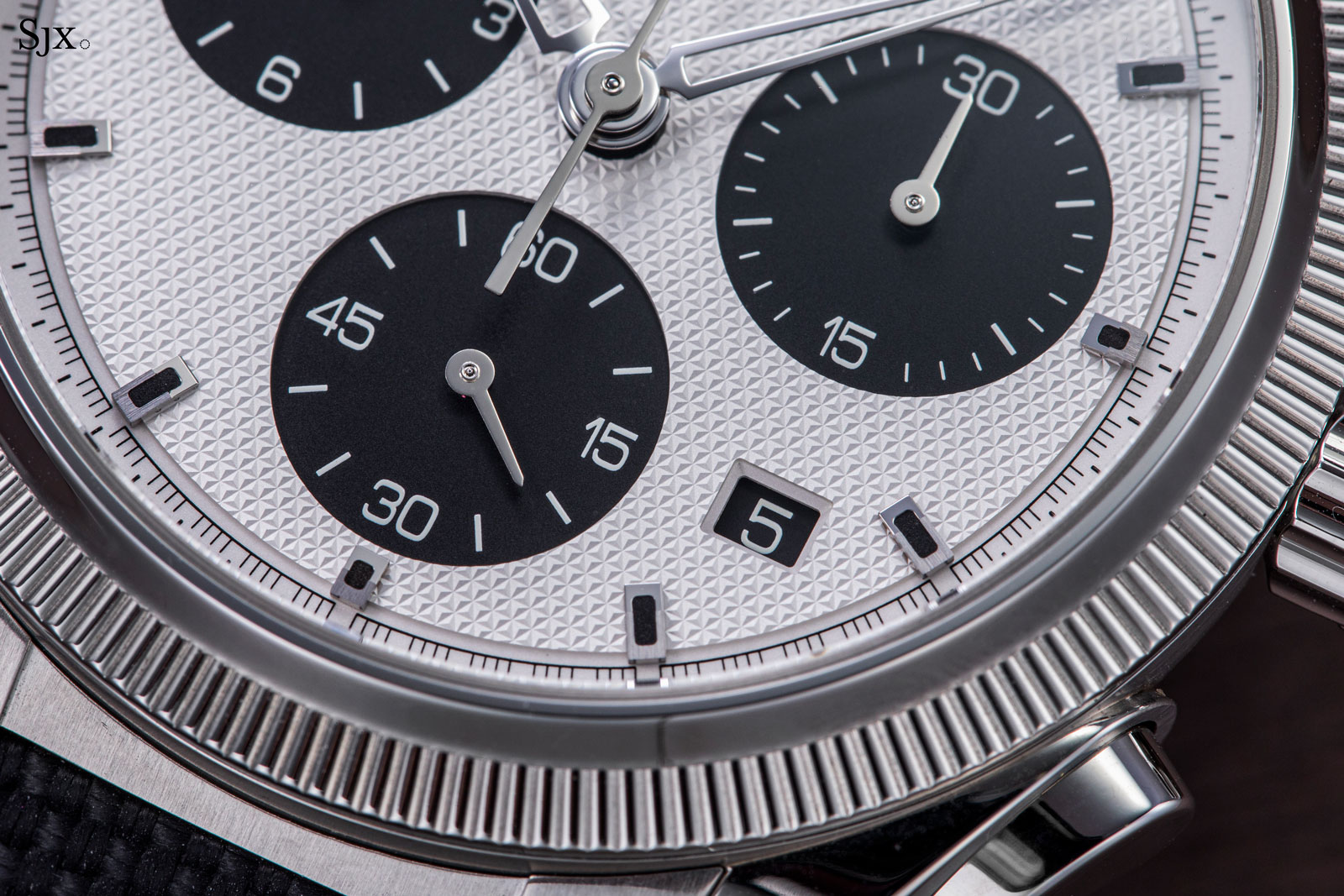
The hands of the Tonda PF Sport retain the javelin form of the PF, but are slightly wider and filled with luminous paint (while the PF has no lume on the dial). Interestingly, the Super-Luminova used for the hands and hour markers is also black, which is great for stylistic consistency, though the visibility of black lume isn’t great in the dark as the glow is modest at best.
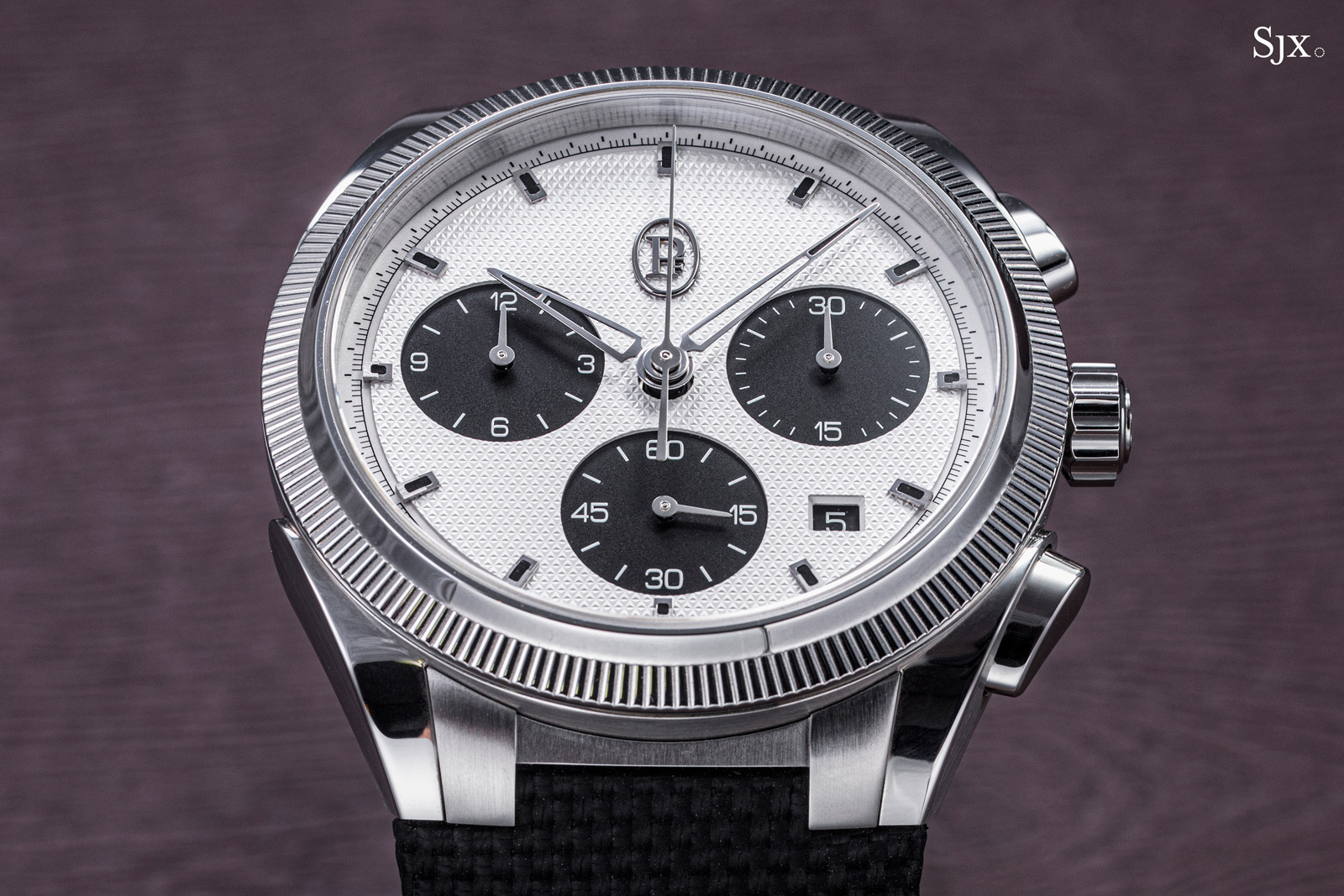
The dial itself is finished with guilloche in a pattern that Parmigiani describes as “triangular nail”. It is essentially a variant of the more common hobnail pattern, but instead of a square, each “nail” is triangular in form. According to Parmigiani, the guilloche is done the traditional way with a hand-operated straight-line engine, which is an appealing bonus.
Although not obvious on its face, the grain of the engine-turned pattern contributes substantially to the overall look. The more prominent the pattern, the more old-fashioned a dial appears. Here the pattern is small enough that it appears more like a texture at a distance, which suits the modern aesthetic. Even though the guilloche offers a great deal of detail under magnification, it preserves the minimalist aesthetic of the dial at arm’s length.
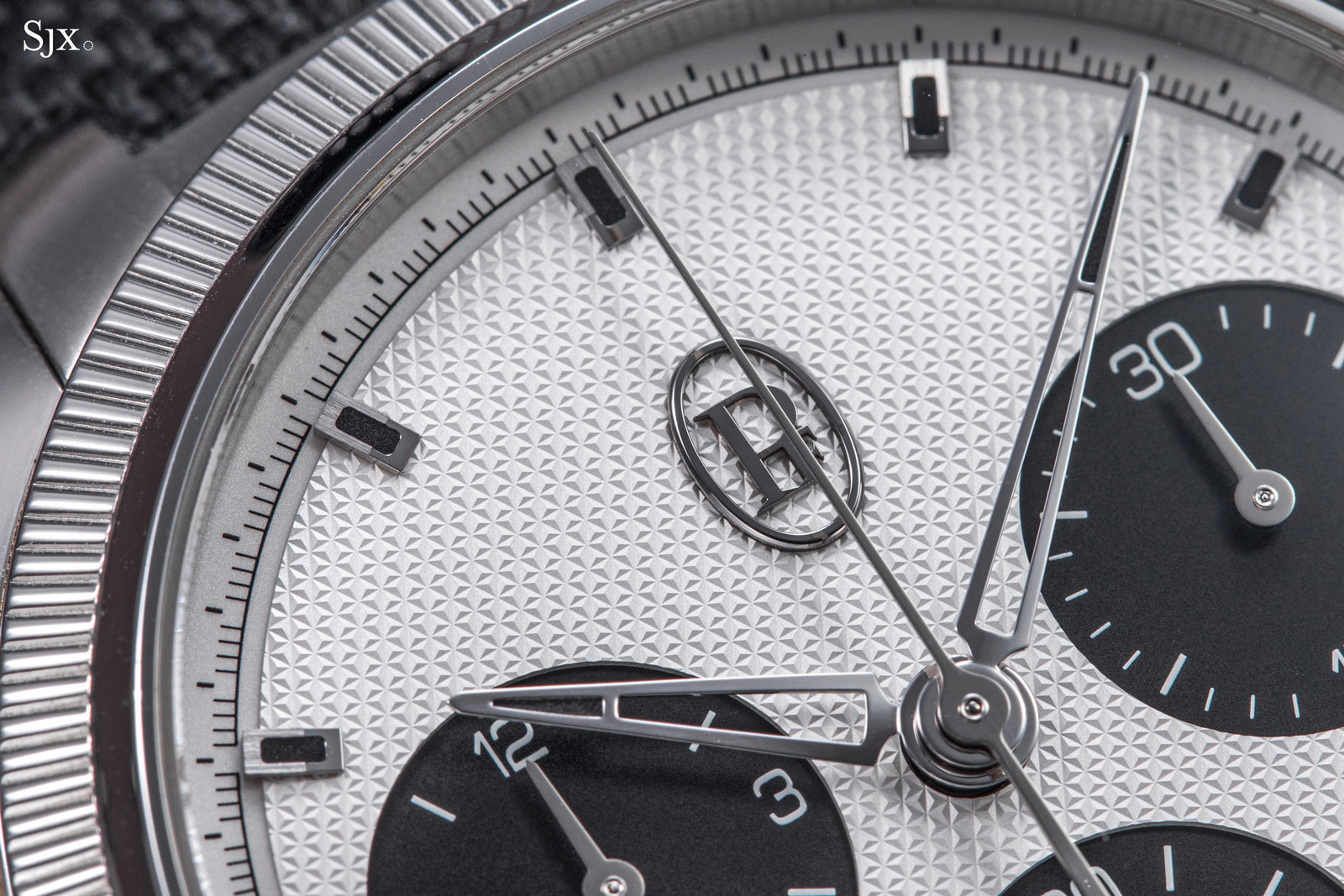
The applied “PF” logo has been the emblem of the brand since its founding in 1996, but it was always applied in a less obvious manner, and only appeared on the dial with the launch of the Tonda PF three years ago
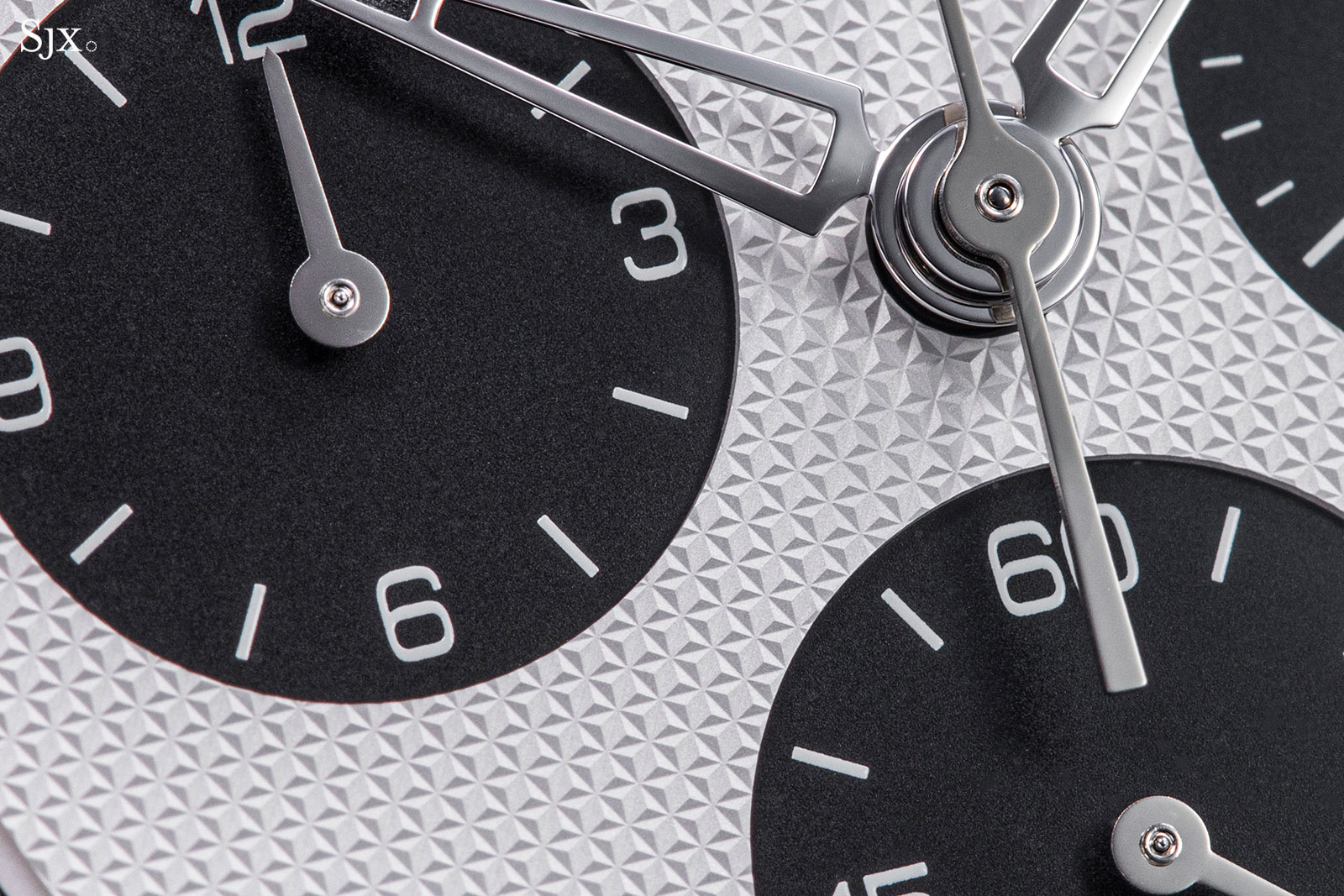
Concluding thoughts
Although an evolution of the Tonda PF at heart, the Tonda PF Sport manages to be a different, but appealing, watch when examined up close. Its slightly larger size and sportier styling give it a more modern, casual appearance than the PF.
As expected, the quality of execution is high throughout, but particularly in the movement, which is the biggest strength of the watch. The construction of the PF070 sets it apart as one of the more sophisticated chronograph calibres on the market today.
I do think a bigger price differential between this and the Tonda PF would be logical, which would also make this a more attractive value proposition. Alternatively, the PF Sport could be offered with a steel bracelet, but at a lower price than the PF – that would similarly serve to differentiate the two.
Key facts and price
Parmigiani Fleurier Tonda PF Sport Chronograph
Ref. PFC931-1020001-400182 (stainless steel)
Ref. PFC931-2020001-400182 (pink gold)
Diameter: 42 mm
Height: 12.9 mm
Material: Stainless steel or pink gold
Crystal: Sapphire
Water resistance: 100 m
Movement: Cal. PF070/6710
Features: Hours, minutes, small seconds, date, and chronograph
Frequency: 36,000 beats per hour (5 Hz)
Winding: Automatic
Power reserve: 65 hours
Strap: Rubberised fabric with folding clasp
Availability: At Parmigiani Fleurier boutiques and retailers
Price:
Stainless steel – US$30,000, or 46,610 Singapore dollars
Pink gold – US$49,500, or 76,830 Singapore dollars
For more, visit Parmigiani.com.
This was brought to you in partnership with Parmigiani Fleurier.
Back to top.